Nili

December 2022
‰
CHANGING THE LENS
Yosha ’07
empowers houseless youth through filmmaking.
As you think about ways to care for the people and communities closest to your heart this season, we hope you will consider a gift to Reed.
Gifts bolster the academic program, animate campus life, and strengthen the financial aid that brings the Reed experience within reach for students.
WILL YOU MAKE A GIFT IN SUPPORT OF REED’S CLOSE-KNIT COMMUNITY TODAY?


Give at reed.edu/knit.

 Artwork by Meredith Jensen
Artwork by Meredith Jensen


FEATURES 14 Changing the Lens Nili Yosha ’07 empowers houseless youth through filmmaking. BY AMANDA WALDROUPE ’07 DEPARTMENTS 2 This Must Be the Place 3 Mailbox 4 Eliot Circular NEWS FROM C AMPUS National Science Foundation Grant Opens Doors for Change Reed at the White House New Members on the Board of Trustees 8 Advocates of the Griffin ALL THINGS AL UMNI Letter from the Chair of Alumni Fundraising for Reed Alumni Board Committees are Back in Action Nomination Nation 10 Retiring Professors John Essick Douglas Fix Jeff Parker Lisa Steinman 22 Reediana BOOKS, FILM, AND MUSIC B Y REEDIES 24 Class Notes NEWS FROM OUR CLA SSMATES 30 In Memoriam HONORING CLA SSMATES, PROFESSORS, AND FRIENDS WHO HAVE DIED A Quest for Meaning: Barbara Ehrenreich ’63 A Leader of Sustainable Growth in Oregon: Robert Stacey Jr. ’72 40 Object of Study WHA T REED STUDENTS ARE LOOKING AT IN CLASS Spiritual Ecstasy
photo by mason trinca 14 10 1 Reed Magazine december 2022
Cover photo by Mason Trinca
Evergreen
Greenery is something that distinguishes the Pacific Northwest and Reed’s beautiful campus. The generally abundant rainfall—affectionately known here as “liquid sunshine”—produces a lushly verdant environment. Even in the depths of winter, Douglas fir trees and other evergreens bring color, scent, and vibrancy to counter seasonal darkness. When Cheryl and I first moved to Portland, we often remarked on how green everything is here. It has been a constant we can count on.
One aspect of a life spent on college campuses is the steady stream of young people who arrive each year. At Reed, I am continually surprised by how bright and original our students are. Their independent mindedness is a source of inspiration.
This issue’s feature on the work of alumna Nili Yosha ’07 illustrates just how visionary and influential our students and alumni can be and why the world needs more Reedies. I particularly loved learning that long before she arrived at Reed as an undergraduate, Nili dreamed of the “ultimate humanist school.” Her desired qualities match Reed perfectly: “a school with a beautiful campus, with small classes, engaged teachers, where grades didn’t matter, an egalitarian, trust-based community, where there were ‘people with brains that you could talk to.’”
It is abundantly clear from Nili’s story that she helps young people who are houseless experience agency and creativity in the face of enormous challenges. By teaching filmmaking and storytelling, she gives them a sense of purpose. One can also see that she listens to and learns from her students and creates the kind of engaged educational community she found at Reed.
Reflecting on amazing things our alumni accomplish in their lives beyond Reed, I am led to think about one concept that motivates me in seeking support for our college—“in perpetuity.” I want students across generations to find their dream school here.
As Reed continues to renew itself over time, it will be important to preserve the elements that distinguish us—the ones that Nili dreamed of—and to continually co-create a special environment where students can find kinship and belonging within a rigorous and empowering academic program.
While our school color may be Reed red, our mission and purpose are evergreen, now and in perpetuity.
Audrey Bilger President of Reed
december 2022
www.reed.edu/reed-magazine reed.magazine@reed.edu
3203 SE Woodstock Boulevard, Portland, Oregon 97202 503/777-7591
Volume 101, No.4
REED MAGAZINE
editor Katie Pelletier ’03 503/777-7727 pelletic@reed.edu
writer/In Memoriam editor
Randall S. Barton 503/517-5544 bartonr@reed.edu
art director Tom Humphrey tom.humphrey@reed.edu
class notes editor
Joanne Hossack ’82 joanne@reed.edu
Reediana editor Robin Tovey ’97 reed.magazine@reed.edu
grammatical kapeLlmeister Virginia O. Hancock ’62
REED COLLEGE RELATIONS vice president, college relations and Planning
Hugh Porter INterim director, communications & public affairs
Aimee Sisco
Reed College is an institution of higher education in the liberal arts and sciences devoted to the intrinsic value of intellectual pursuit and governed by the highest standards of scholarly practice, critical thought, and creativity.
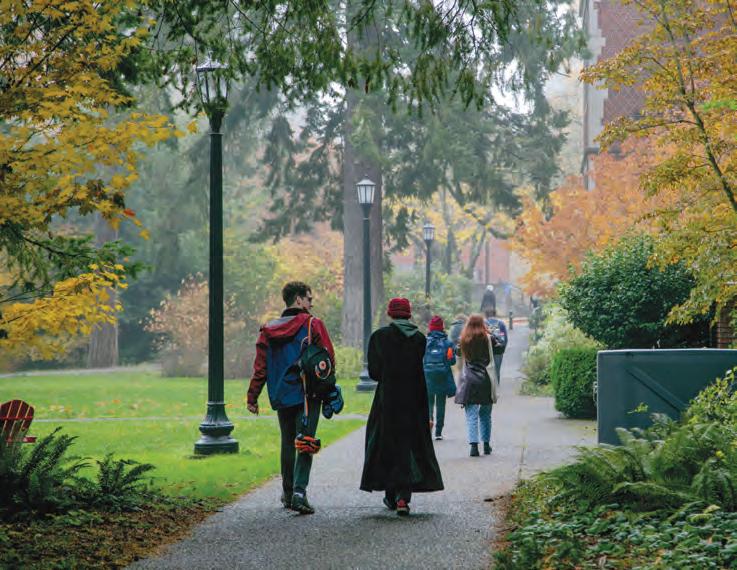
Reed Magazine provides news of interest to the Reed community. Views expressed in the magazine belong to their authors and do not necessarily represent officers, trustees, faculty, alumni, students, administrators, or anyone else at Reed, all of whom are eminently capable of articulating their own beliefs.
Reed Magazine (ISSN 0895-8564) is published quarterly by the Office of Public Affairs at Reed College. Periodicals postage paid at Portland, Oregon.
Postmaster: Send address changes to Reed Magazine 3203 SE Woodstock Blvd, Portland OR 97202-8138
‰
This Must Be the Place
2 Reed Magazine december 2022
photo by cornelia soma penn ’24
Mailbox
Write to us! We love getting mail from readers. Letters should be about Reed (and its alumni) or Reed Magazine (and its contents) and run no more than 300 words; subsequent replies may run only half the length of their predecessors. Our decision to print a letter does not imply any endorsement. Letters are subject to editing. (Beware the editor’s hatchet.) For contact information, look to your left.
Measuring a Handful
In the spirit of eschewing self-congratulation in all its forms, in “Understanding Reed’s Endowment” (March 2022), the statement “Reed is one of only a handful of colleges that commit to meeting 100% of the demonstrated need of all admitted students” might be correct, but, in my understanding, only if we’re dealing with a rather large hand, or if colleges are somewhat smaller than I imagine them. Precision is challenging here, but the reputable-or-not website Cappex suggests that there are 87 such colleges.
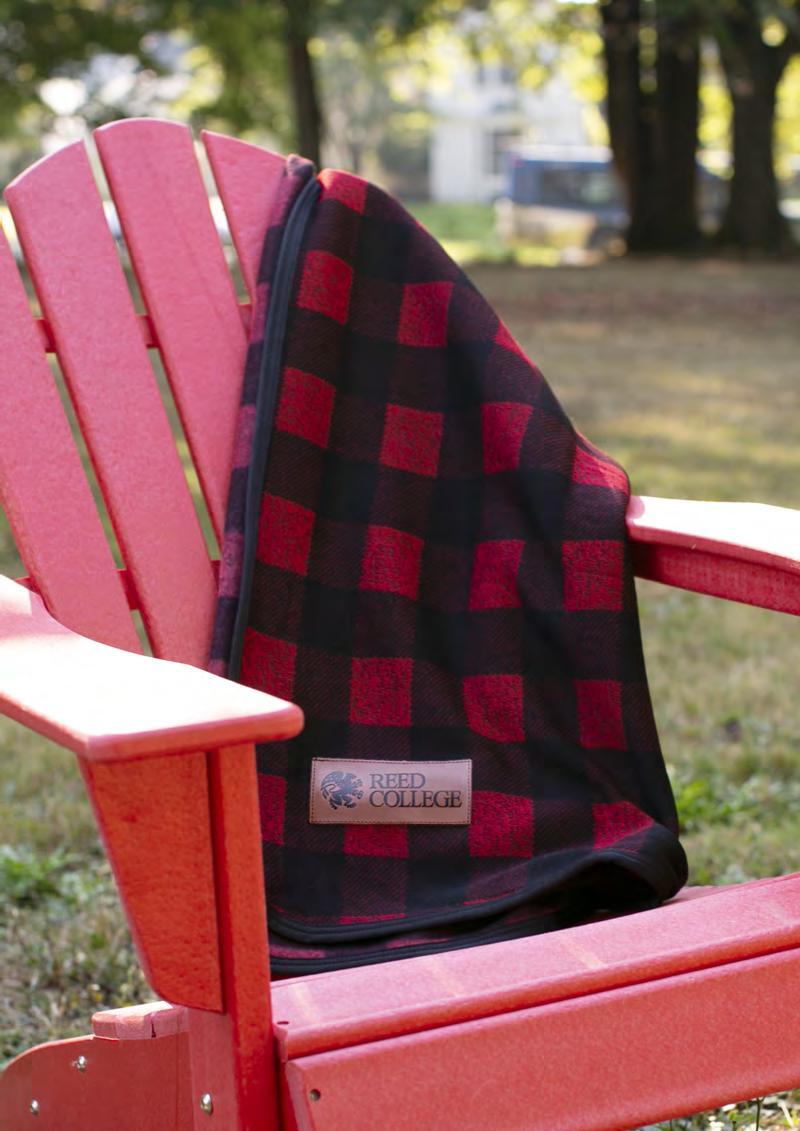
I’d be interested to hear from admission or financial aid on this. As someone whose child has recently experienced the wonderful college admissions process (he didn’t end up going to Reed—I failed!), the desirable center of the admissions and financial aid Venn diagram seems to be “need blind, demonstrated need without loan,” which, according to prepscholar.com—no idea of its reliability—12 colleges satisfy, only four of which I’d consider in Reed’s peer group (Amherst, Bowdoin, Pomona, and Swarthmore).
In addition to nitpicking, I’d like to thank author Chris Lydgate for the many years of information and entertainment.
Tyler Abbott ’84 San Francisco, California
From the Editor: I'm happy to share some context about that handful. While 87 colleges might seem like a lot, it is only 3.06% of the 2,845 four-year colleges and universities in the U.S. With an endowment that is, on average, about one-quarter the size of the peer institutions you mention, Reed's commitment to meeting full demonstrated need, even when families' financial circumstances change, stands out. It's worth noting, too, that Reed students graduate with a debt burden that is below the national average. We owe a lot to alumni, parents, and friends of the college whose generosity enables this financial support. And we hope that someday we'll be part of a giant "armload"—or more—of colleges that also meet 100% financial need.
Looking for the perfect gift? We've got you covered. Visit us for a great selection of gifts, both large and small. bookstore.reed.edu
Eliot Circular
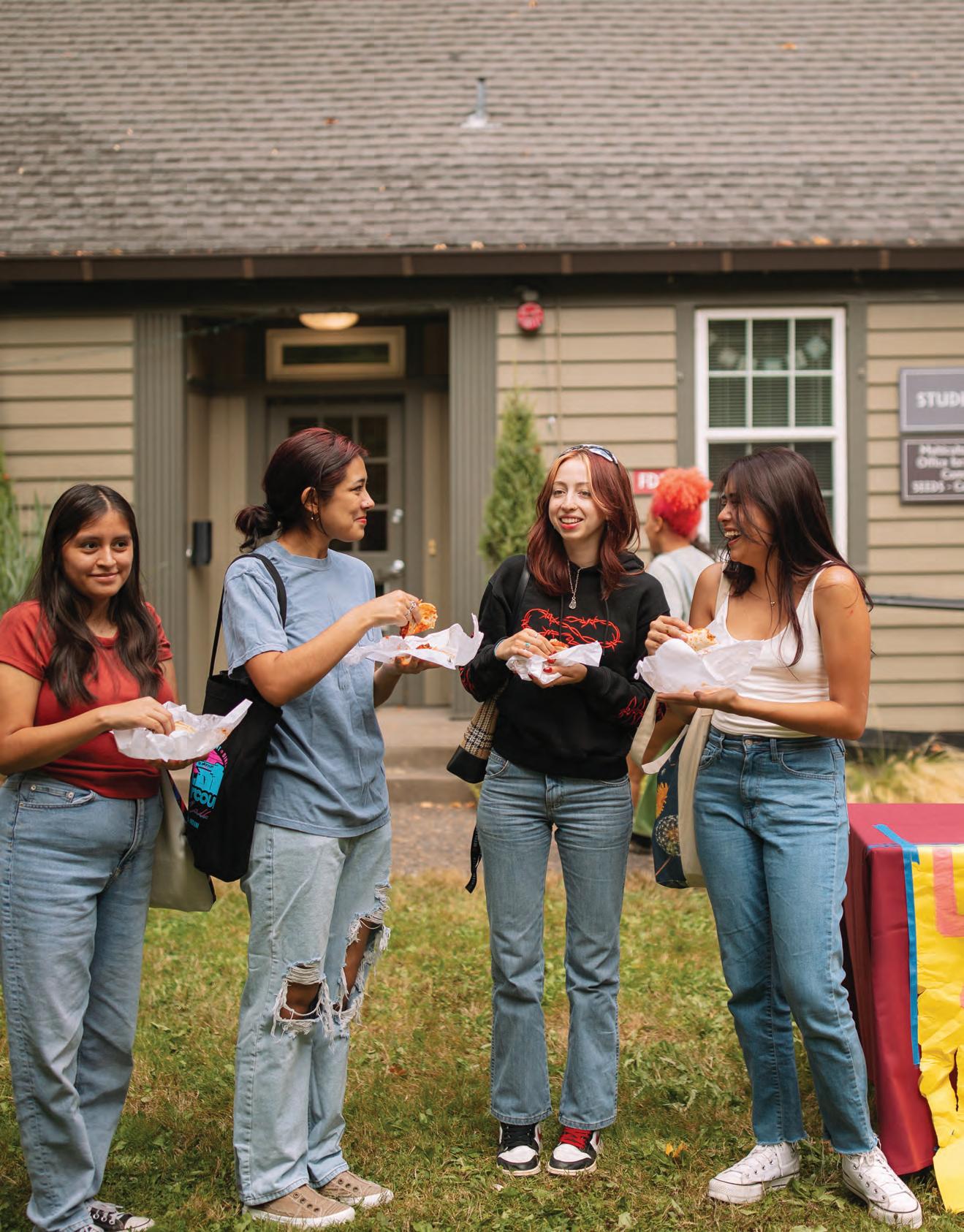
news from campus
National Science Foundation grant opens doors for change
BY ANNA JOHNSON
A National Science Foundation (NSF) grant will allow Reed math professors Angélica Osorno and Kyle Ormsby to open doors historically shuttered to underrepresented groups in math—and push the boundaries of an emerging field.

Osorno and Ormsby are once again teaming up on an NSF grant to expand their research in homotopy theory, a growing branch of algebraic topology that combines the two basic elements of math: numbers and shapes.
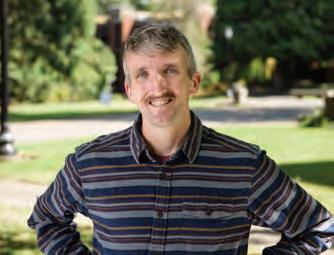
The three-year, $345,000 award supports the professors’ individual and joint homotopy theory projects. It also revives the successful Collaborative Mathematics Research Group (CMRG) and extends their existing work on initiatives aimed at enhancing inclusivity in mathematics, such as a Women in Topology workshop in Germany; the Mathematics TeacherScholar Symposium (MaTSS); and Reed’s SL(m) group which fosters connections among math students and faculty.
The professors launched the CMRG as a summer research opportunity for students in 2018 with funding from their prior NSF grant. The group challenges underrepresentation in math by providing fertile ground for diverse cohorts of students to explore unsolved topology questions and to contribute to solutions.

Each summer for the next three years, five students will be selected for an eightweek program at the CMRG. Because homotopy theory is graduate-level math, Osorno and Ormsby will run a two-week
bootcamp to bridge the gap by building on participants’ existing knowledge and previous coursework. One of the projects students will work on involves topological data analysis, which may have implications for diagnosing different types of Alzheimer’s disease and related disorders.
Sixteen students have taken part in the CMRG since its debut. Many have had their CMRG work published in professional math journals, and roughly half have gone on to pursue graduate education in math. Maxine Calle ’20 was originally a philosophy major who participated in the CMRG in 2019 and is now a PhD student at the University of Pennsylvania, where she continues the research on homotopy theory that sparked her imagination as an undergraduate. “When I started at Reed, I had no idea that I would end up studying math, much less go to graduate school for math,” she says. “It’s fair to say I am where I am, and do what I do, in large part because of Kyle and Angélica.”
Ultimately, Ormsby says, their vision of success is as much about discovering new math that could have future utility for society as it is about building an inclusive, vibrant community of scholars. The homotopy theory community has taken notice of Ormsby and Osorno’s work with undergraduates at Reed and is now replicating it at their own institutions. “A lot of the math in this project we approach much more like an artist approaches a new sculpture or painting than like an engineer approaches designing a new airplane,” Ormsby says. “We’re excited about the ideas, the connections, and the beauty inherent in all of it.”
5 Reed Magazine December 2022
Prof. Angélica Osorno Prof. Kyle Ormsby
Emely Cruz ’26, Victoria Salazar ’26, Marta Davila-Lomas’26 and Emilly Gonzales ’26 enjoy tacos at the Latinx Student Union’s Tacos and Helado Social held in September.
photo by lauren labarre
Reed at the White House
BY RANDALL S. BARTON
In August, President Audrey Bilger traveled to Washington, D.C., to meet with U.S.Vice President Kamala Harris and seven other college presidents to discuss how colleges are responding to the Supreme Court’s Dobbs decision. That decision held that the Constitution of the United States does not confer a right to abortion, resulting in states now having full power to regulate any aspect of abortion not preempted by federal law.
“As the first woman president of Reed College, I was pleased to be able to meet with the first woman vice president of this country, and the first vice president of color in this country,” Bilger said. “There’s something important about firsts.”
At the White House meeting, Bilger read a statement that said, in part, “The decision has put the college on high alert, leaving an unwieldy patchwork of laws and restrictions that vary from state to state. In Oregon, there may be relative safety, but college students are vulnerable to having their rights undermined simply by leaving this state to return to their hometowns, to engage in internships, or conduct research elsewhere in the United States.
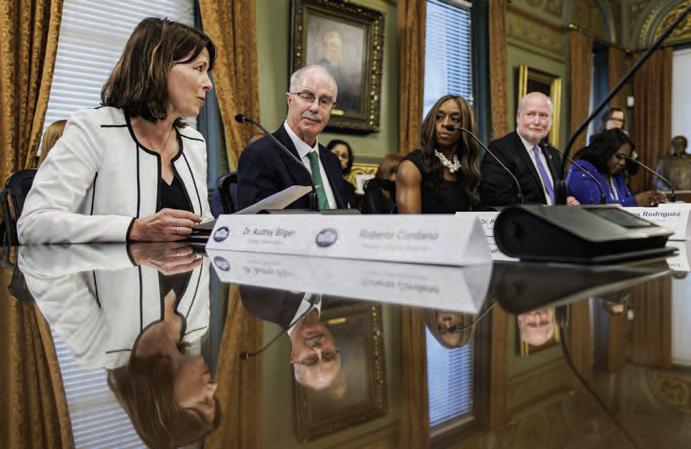
“We are also acutely aware of the threat of future decisions by the U.S. Supreme Court that could further erode the right to privacy by potentially restricting access to contraception, or invalidating marriages between samesex couples, or criminalizing homosexuality, or permitting the persecution of transgender and gender-nonbinary people.”
At the time of the meeting, most colleges hadn’t begun their semesters, and the vice president suggested it would be beneficial to talk to student leaders. In mid-October, she hosted 75 student leaders from 33 states and specifically asked that a student from Reed be included.

Reed sent Peri Joy Long ’23, a senior from Annapolis, Maryland, majoring in religion and planning to go on to law school. For the past two years, she has worked on campus as a certified confidential advocate with legal privilege for survivors of sexual assault through SHARE (Sexual Health, Advocacy
and Relationship Education). She has also worked on public policy in Oregon, landing a Summer Internship Award though the Center for Life Beyond Reed, which enabled her to conduct research and help draft Oregon state bills to support victims of sexual violence with the Every Voice Coalition. Students who would speak at the
White House were preselected by a nonprofit organization that helped organize the meetup with Harris. Peri was not one of them, but she came prepared anyway. When the group session broke to pose for pictures, Peri ended up next to the vice president. As the photo session concluded, Harris turned to Peri and said “Thank you for coming.”
Eliot Circular 6 Reed Magazine december 2022
Reed senior Peri Long ’23 (right of U.S. Vice President Kamala Harris) after a meeting with the VP in the White House.
Reed President Bilger met with U.S. Vice President Harris to discuss the Supreme Court’s Dobbs decision.
Photo by Sam Corum / upi
Introducing herself, Peri said, “With my work, my primary concern is the intersection of Dobbs and the sexual violence epidemic. The fact that we’re seeing this sexual violence epidemic on campuses grow rapidly, and that the right to abortion is a now a geographic privilege, is a major concern that could further bind women and nonbinary people from access, education, or continuing education, not to mention the mental or psychological effects.”
She shared statistics that show one in four women are likely to experience sexual assault, a number that is even higher for students who are nonbinary, LGBTQ, or other historically marginalized identities.

“Thanks so much for bringing this to my attention,” Harris replied. “Those are some angles we hadn’t really thought about and will definitely take into consideration.”
The students then met with the vice president’s staff members to discuss how the White House might better reach students in combating misinformation about abortion and ways to get students to vote. “They called on us to go back to campuses and inspire students to vote,” Peri said. “Historically things have happened quickly when students have gotten involved with something.”
Reed welcomes four new trustees.
Julie Cheng ’84
Julie is the owner and principal of New Bamboo Consulting, a boutique firm specializing in business and management consulting with a focus on early-stage companies and nonprofits, especially those that contribute to the development of new products for the global health community. She has spent more than 30 years in the biopharmaceutical industry in the business development and corporate legal fields, with a focus on international intellectual property. Julie is a coauthor of “Socially Responsible Licensing, Euclidean Innovation, and the Valley of Death,” which was published in the Stanford Journal of Law, Science & Policy. She graduated from Reed with a BA in chemistry in 1984 and then earned a JD from University of New Hampshire.
Ritankar “Ronti” Pal ’93
Ronti is the chief operating officer of Molekule, an air purification company on a mission to deliver clean air to everyone everywhere. He previously served as chief financial officer of PayActiv, a financialwellness platform. From 1993 to 2012 he worked on Wall Street; he was managing director at Citigroup and, later, the managing director and head of U.S. Dollar Interest Rates Trading at Barclays Capital. He attended Reed and the California Institute of Technology (Caltech) on a full scholarship to the 3-2 program, graduating from Reed with a BA in mathematics in 1991, and with a BS in engineering and applied science from Caltech in 1993. He is a member of the President’s Advisory Council, has served as an Alumni Fundraising for Reed volunteer, and as a reunions gifts chair. He and his wife Jaya have two children.
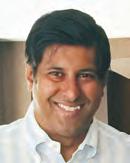
Carla Beam ’76
Carla spent more than 40 years leading and advising Alaska private, public, and nonprofit entities in communications, public affairs, development, and governance. She retired in 2015 from her final position as University of Alaska vice president of university relations and president of the University of Alaska Foundation. She has been a volunteer leader, serving on numerous nonprofit boards. Currently she chairs the Anchorage Museum Association board and serves as a member of the Anchorage Museum Foundation board. She has volunteered with Alumni Xenia, Alumni Fundraising for Reed, and her 45th and 30th reunion committees. She has also served as an alumni local host, admission volunteer, career network volunteer, and an Oral History Project participant.
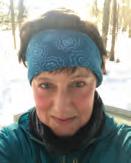
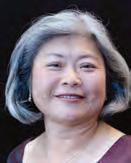
Peter J. Bragdon
Peter serves as executive vice president, chief administrative officer, and general counsel for Columbia Sportswear, which he joined in 1999. He previously served as chief of staff in the Oregon governor’s office, an attorney in the corporate securities and finance group at Stoel Rives, special assistant attorney general for the Oregon Department of Justice, and commissioner for the Port of Portland. He began his career as a journalist, serving as an intern at the Oregonian and then writing for Congressional Quarterly Weekly Report in Washington, D.C. He graduated from Amherst College with a BA in political science and went on to earn an MLS from Yale University and a JD from Stanford University. He and his wife Ellen have three children. His late father was former Reed President Paul Bragdon.
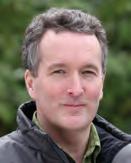
7 Reed Magazine December 2022
Official White House Photo/Lawrence Jackson
Advocates of the Griffin
A community of individuals makes Reed go ’round
Each semester, Reedies return to campus. They take new classes, return to their favorite places in the library, attend office hours, and resume midday walks to the Paradox. They gather for morning lectures in Vollum and latenight dances in the SU. Every year, through the contributions of individual students, faculty, and staff, this community is created anew, animated by a shared drive to think deeply, inquire widely, and problem-solve creatively.
Our community of alumni, parents, and friends shares this same drive, and its
members make their own contributions through financial support of the college every year. Financial aid, in particular, is critical in supporting each student’s ability to participate fully in the Reed experience. The college meets 100% of demonstrated financial need for every student, and this year 54% of students received an average of $53,000 in financial aid. Gifts of all sizes support a transformative education for Reedies across the socioeconomic spectrum.
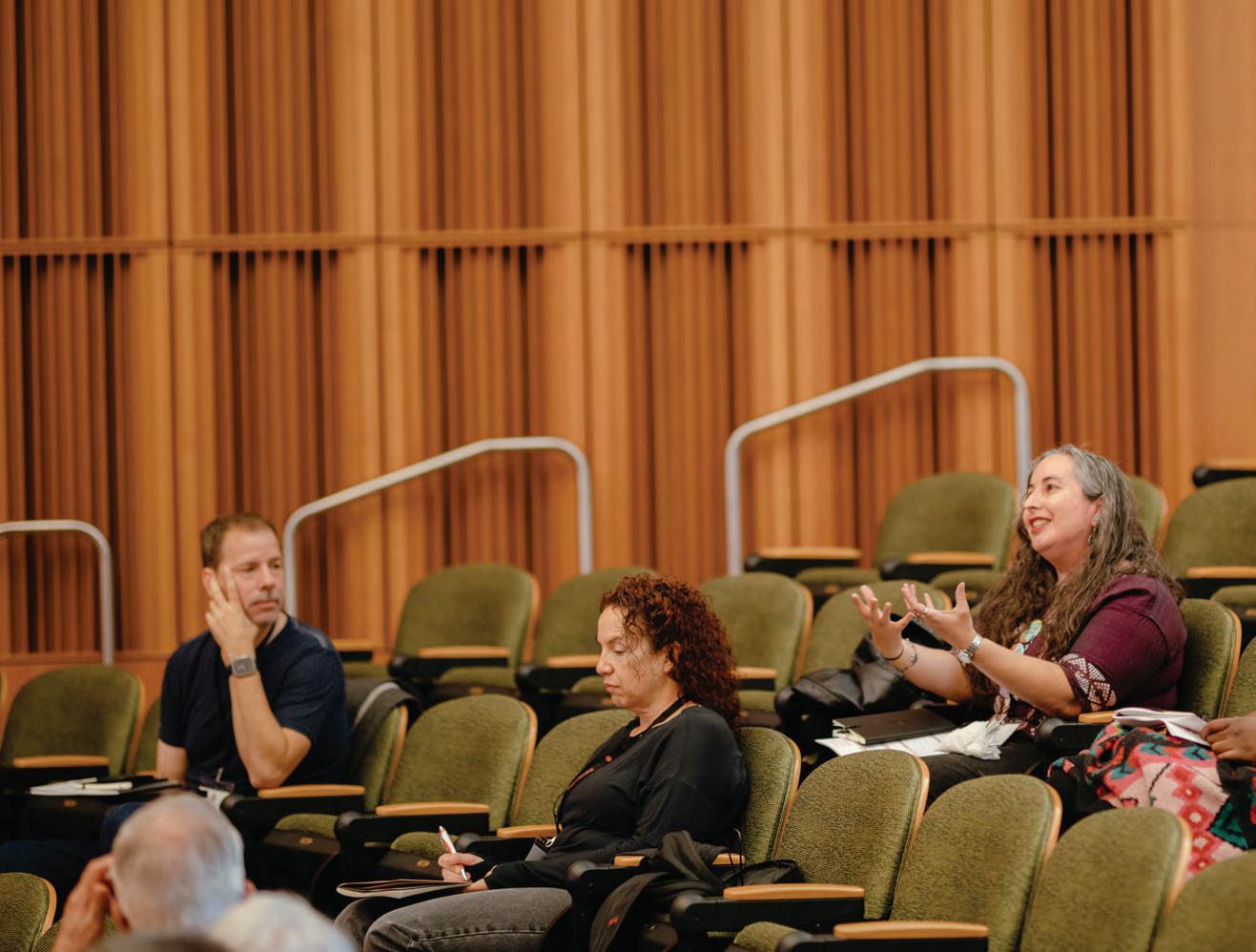
Every member of the Reed community comes together to make Reed what it is, and so does every gift. The collective
impact of each and every contribution to the college makes this very special place go ’round.
I hope you’ll join our community of donors in giving the gift of Reed (again) this year.
Warmly,
Kyndra Homuth Kennedy ’04 Chair, Alumni Fundraising for Reed
Are you especially passionate about Reed? If so, email alumni@reed.edu to join Alumni Fundraising for Reed and advance the mission of the college.

8 Reed Magazine december 2022
Alumni ask questions during a presentation by Dean of the Faculty, Professor Kathy Oleson [psychology] at the Forum for Advancing Reed in October.
News of the Alumni Association • Connecting Reed Alumni Around the Globe
REUNIONS 2023: JUNE 8–11
Save the date and get involved!
Does your class year end in a 3 or an 8? Are you longing to reconnect with friends and debate exactly when Olde Reed died? Reunions 2023 planning is underway, and we are looking for quippy, quickwitted, quintessential Reedies* to join quinquennial class committees. Try saying that three times fast! Learn more about volunteering for your class committee by emailing alumni@reed.edu.
*Specific qualifications encouraged, but not required.
Alumni board committees are back in action!
After a nine-month hiatus, we are happy to announce that alumni board committees are back. Here’s a sneak peek at what’s to come as committees regroup and begin planning for 2023.
Committee for Young Alumni
Expand the volunteer base and infrastructure of the Pathfinders program (connecting recent alumni with young professionals to discuss post-Reed life and career options). Compile an alumni-to-alumni welcome packet for the newest members of the alumni community.
Diversity & Inclusion Committee
Continue to cultivate and grow identity-based affinity networks and programming. Current networks include alumni of color, first-generation alumni, and LGBTQIA2S+ alumni. Relaunch working groups dedicated to special projects.
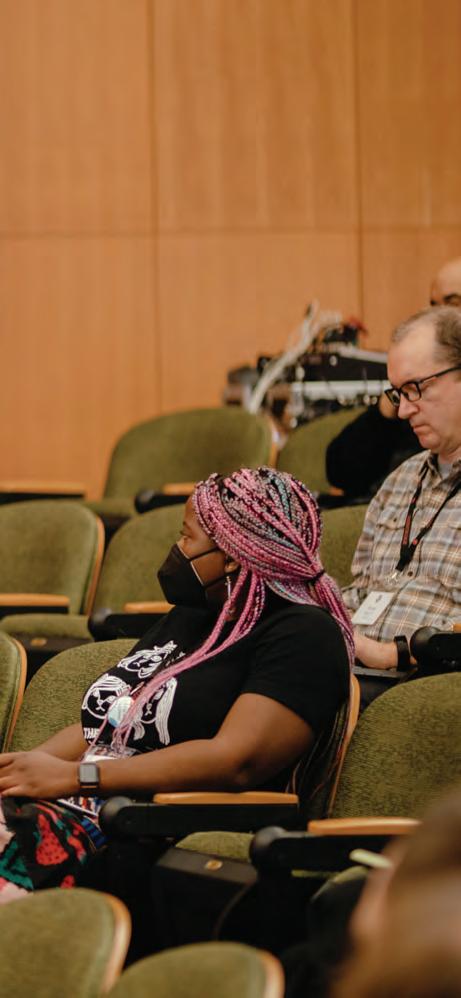
Reed Career Alliance
Continue to support existing programs, including alumni career coaches and professional networks. Relaunch career pathway panel discussions in the new year. Topics will include gender minorities in tech and careers in sustainability. To learn more and volunteer for a committee, visit alumni.reed.edu/ board_of_alumni.
REED ON THE ROAD
March 8: Portland, OR
March 13: Washington, DC
March 15: Chicago, IL
March 16: Los Angeles, CA
Gather with fellow Reedies to connect in conversation, enjoy a faculty talk, and hear important updates from the college. Learn more at alumni.reed.edu/ reed-on-the-road.
NOMINATION NATION
The nominating committee of the board of directors of the alumni association proposes the following nominees to serve terms on the alumni board beginning April 22, 2023.
Nominee for Alumni Trustee: Tina Sohaili-Korbonits ’07
Nominee for President: Dylan Rivera ’95
Nominee for Vice President: Andrei Stephens ’08
Nominee for Secretary: Katie Rempe ’05
Nominees for At-Large Director: Claire Dennerlein Manson ’02, Caitlin McKenna ’08, Bronwyn North-Reist ’07, Vasiliy Safin ’07, and Alix Sanchez ’08
Nominees for Chapter Leadership Council: H Gray ’08 and Jim Quinn ’83
Nominees for 2022–23
Nominating Committee: Dave Baxter ’87 (past president, chair), Dylan Rivera ’95 (president), Christine Lewis ’07, Josh Cox ’18, and Becky Chiao ’85. Please find additional details on the nominees and petition process on alumni. reed.edu.
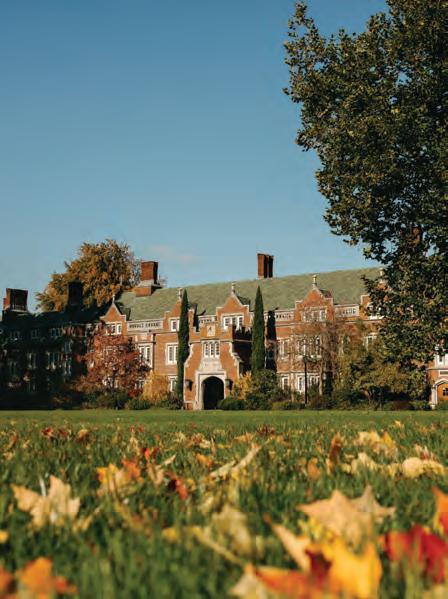
9 Reed Magazine december 2022
photos by lauren labarre
Wizard of experimental physics
Professor John Essick [physics 1993–2022]

My path to teaching at Reed differed from the more typical and direct route of graduate student to postdoc to tenuretrack professor. After earning my master’s degree, I spent a good portion of my 20s as a “freeway flier” physics instructor in my hometown of Los Angeles, teaching at more than a handful of colleges and universities.
I liked college teaching and wanted to make it my career, so at age 30 and newly married, I moved with my wife, Katie, to Eugene, Oregon, where I earned a physics doctorate. My first tenured job was back in Los Angeles at Occidental College, and, because raising a family in L.A. seemed out of reach financially, I promised Katie we wouldn’t be there forever. Thus, four years later, I applied for a position at Reed.
I didn’t know what to expect when I arrived on campus for my two-day interview, but I discovered quickly that Reed was quite different from all of the other (by then, eight) institutions at which I’d
taught. The physics faculty were topnotch, the college was supportive of faculty developing new programs, and the physics majors . . . well, there were a lot of them (among liberal arts colleges, Reed consistently is one of the top 10 producers of graduating physics majors in the U.S.). The barrier I’d always felt between teacher and student at other schools seemed greatly diminished at Reed. Reed students made me feel like I had valuable knowledge to share and we were on a journey to educate each other. And, the clincher: a yearlong thesis required of all seniors.
My three decades of working at Reed have only amplified my initial positive impressions. I’ve been fortunate that my role within the physics department has always been clear: to help develop the experimental physics program. When I arrived, my solid-state physics experimental research skills and interests were narrowly focused on my area of expertise, the optical and electrical properties of semiconductor materials. However, my research program could only support
one or two of the three or four (or, even once, five) thesis students I worked with every year, so I branched out. While about half of my 72 thesis students carried out projects related to my field, the other half and I explored interesting topics in atom trapping, quantum optics, cosmic-ray muons, chaos, room acoustics, nuclear fusion, novel musical instruments, and more. In addition, with an abundance of support from my physics colleagues and the college, I focused on developing the instructional physics laboratory program, especially the junior-level Advanced Laboratory, and it’s been very satisfying to witness the research skills of Reed students grow in these courses.
In my curricular and thesis work, I’ve appreciated the one-on-one time I’ve been able to spend with so many gifted student collaborators. Finally, as the years have gone on, it’s been a joy to keep in contact with many of my students. I love following the paths their lives (and Reed education) have taken them. I couldn’t have asked for a better place to be a teacher. Thank you, Reedies!
REFLECTIONS
Emeritus Faculty look back on their time at Reed.
10 Reed Magazine december 2022
Wandering paths and deep engagement
Professor Doug Fix [history

1990–2022]
I came to Reed in 1990 with much baggage: eight years’ residence in Taiwan; two years teaching English at a Taiwanese university; several years TAing for UC Berkeley history courses; obsolete skills creating diacritic bitmaps for a Gothic dictionary; several boxes of books; and a small family, but no dog. Thirty-two years later, I vacated my office with 40-some boxes of books, a dumpster of teaching materials, an armful of students’ creative projects, and still no dog. In between those two dates, I taught numerous seminars on Chinese, Japanese, and East Asian history, helped create the Chinese humanities courses, advised 70-some senior theses, and published three books and many articles (one with a Reedie as coauthor) on Taiwan’s modern history.
It took me years to coordinate my teaching and research foci, but that wandering path enabled a deep engagement with historical cartography,
extensive knowledge of East Asian photography, and the practical insight to avoid planting seeds in the canyon for my Rice in East Asia course. Of my accomplishments at Reed College, I am most proud of helping struggling students learn to critically assess disparate sources and thoughtfully articulate historical knowledge in well-documented papers. After a bumpy start, I proved that students from urban centers could be interested in courses devoted to the experiences of farmers, their communities, and crops in historical East Asia. Since 1998, 40 students and numerous colleagues have helped me create, translate, update, or mine the content of my digital collection, “Formosa: Nineteenth Century Images.”
In recent years, I have encouraged students to use Google Earth, Omeka, and related applications to create digital humanities projects rather than the standard research paper. I hope all the students in my history and Chinese humanities courses learned to analyze maps and
visual media as well as the textual sources humanists commonly employ.
Over the years, numerous individuals in the Reed community have helped me avoid the worst pedagogical mistakes, while providing the stimulus for a lifetime of reflection on many topics. Colleagues in history taught me how to teach real seminars, where students and instructors are responsible for successful discussions. With the guidance of faculty experts on Chinese literature, religion, and art history, I gained exceptional knowledge essential to teaching Qin, Han, and Song civilizations. Staff members in so many offices have supported my endeavors, but I’m especially grateful for Trina Marmarelli’s [information technology] digital humanities assistance. With high expectations, I have demanded a great deal of students in my classes, and even more from seniors writing theses with me. Most have exceeded those expectations, while teaching me a great deal about being a human(ist) in the process.
11 Reed Magazine december 2022
A transformational experience teaching at Reed
Professor Jeffrey Parker [economics 1988–2020]
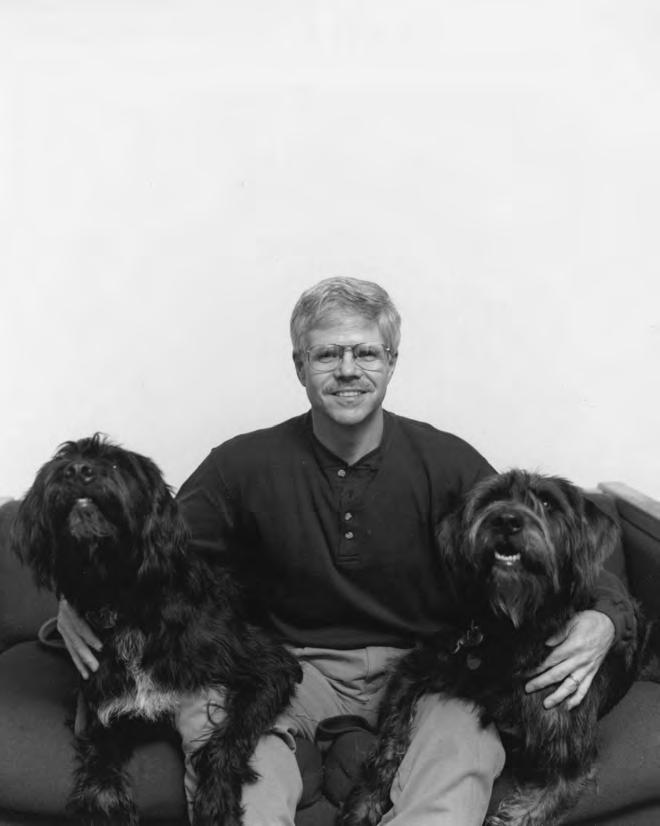
The spring semester of 1998 finished my 10th year at Reed. I must have been a decent teacher before that because the college had given me tenure and promoted me to the George Hay Chair. But that semester yielded insights that fundamentally changed my approach to teaching for my remaining 23 years.
In my first years I discovered that the undergraduate economics textbooks that worked elsewhere were insultingly shallow for Reed students. But both graduate texts and published literature demanded a level of mathematical analysis that was beyond the reach of most Reed students. In 1997, I found a newly published macroeconomics text by David Romer that, though it was aimed at first-year graduate students, was not just endless equations; it had words and actual, coherent explanations of basic theories. Would this work for Reed students? There was a lot in it for which Reed students lacked the expected background. I plotted an experiment: use this text with a standard undergraduate text as backup and attempt to provide the students with the “bridge” material they would need—both economic and mathematical, both written and in person—to overcome the gap between them and the book’s intended audience of graduate students.
The spring 1998 macro class was, in retrospect, a group of unusually strong and dedicated students. They struggled, but we persisted and they eventually thrived on the challenging analysis. I had never spent so much time preparing a course or answering student questions at all hours of the day (and sometimes night). It was wonderful!
The Romer experiment repeated every spring until my final macro class in 2020. The “coursebook” that I wrote (on the fly that first semester) to help them understand Romer’s text grew to
500+ pages and 18 chapters. The lounge area opposite my office became known in the department as “The Romer Lounge” after the collections of students working together on challenging assignments (and frequently traipsing across the hall to my office for help).
That class taught me a fundamental lesson about Reed students, and it transformed my teaching: ask them to work extremely hard at learning, but let them know that I would work equally hard to help them learn. Moreover, the strategies I employed to keep the students engaged
became key elements of my pedagogical style—written work of some kind submitted every class day, aggressive encouragement to communicate with me outside of class, and some assignments done collaboratively in random pairs.
To the macro class of 1998: I owe you a huge debt of gratitude for helping me understand Reed students and how I can help them learn more effectively. I think about you every time I pass our L203 classroom. Thank you!
12 Reed Magazine december 2022
REFLECTIONS Emeritus Faculty look back on their time at Reed.
At home in an intellectual community
Professor Lisa Steinman [English 1976–2022]
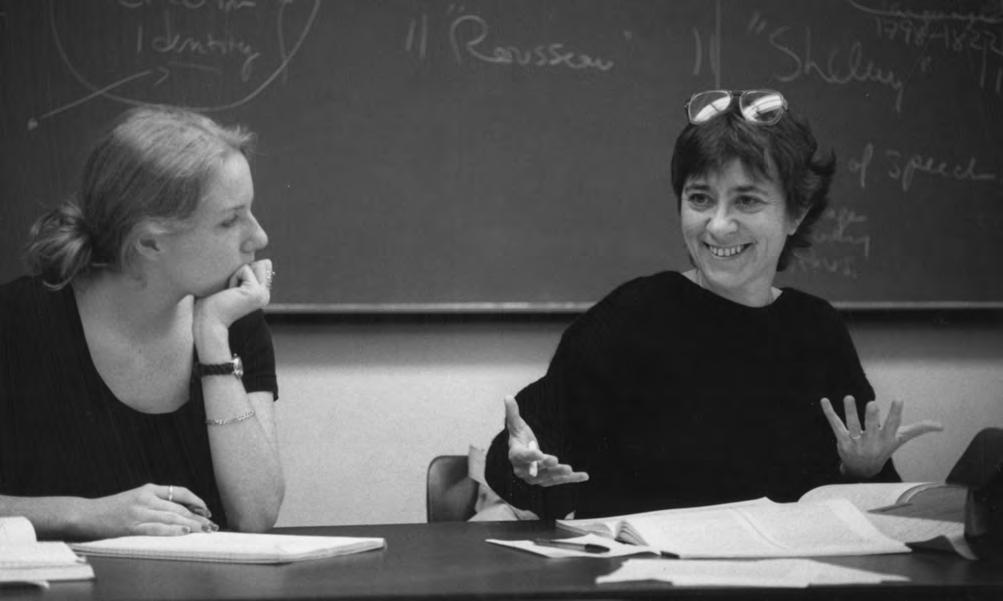
Forty-five years teaching at Reed have given me quite a long view as both Reed and the larger world in which it exists have changed. As have I. I was, after all, 26 years old when I arrived, so it is primarily Reed that formed me and, indeed, educated me—in part through my exchanges with colleagues, many of whom worked in different fields (I even took a physics class at Reed in the 1980s!), but mostly through my conversations with students in classes, in my office, and around campus (including—which will surprise no one who knows me—at the smoking sheds). I still keep in touch with many of these people whom I now count as friends. In short: this is not so much the farewell to former students I was invited to write as it is a tribute to them for giving me
(among other things) new points of view and teaching me humility by making me appreciate and admire various kinds of talent and intelligence that often became most evident in individual discussions in my office or after class, around campus, or over tea. Even before I was hired—at my job interview—Reed seemed to me a nearly ideal place full of people who cared about ideas, who enjoyed thinking and talking about what they were passionate about, forming an intellectual community that felt like home to me.
Reed admittedly always required a good deal of work, however gratifying that work might have been. When I first arrived, Reed was less bureaucratic than it now has to be, although, in my early days, there was a rule that no classes could be capped and no conferences could have more than 15 students, so one “replicated” (as it was called) sections, without extra pay and without course
relief; one year, I taught the equivalent of something like 10 classes. At the same time, Reed did generously allow me to take leaves when I was offered outside opportunities. And one year when I had 75 students sign up for one of my classes, I was able to bargain with the then college president to avoid any committee assignments. Then again, one year I was on one of the major committees, chair of the English department, and chair of some other committee, though I’ve now forgotten which (again, without course relief or extra pay). My husband joked that with one more chair, I’d have a dinette set. That seems a good metaphor to me. The table may not have been fancy, but I’m thankful for what meant most to me: the sense of being nourished by gathering with mostly or at least increasingly younger, interested, and interesting people.
13 Reed Magazine december 2022
CHANGING THE LENS
Nili Yosha ’07 empowers houseless youth through filmmaking.
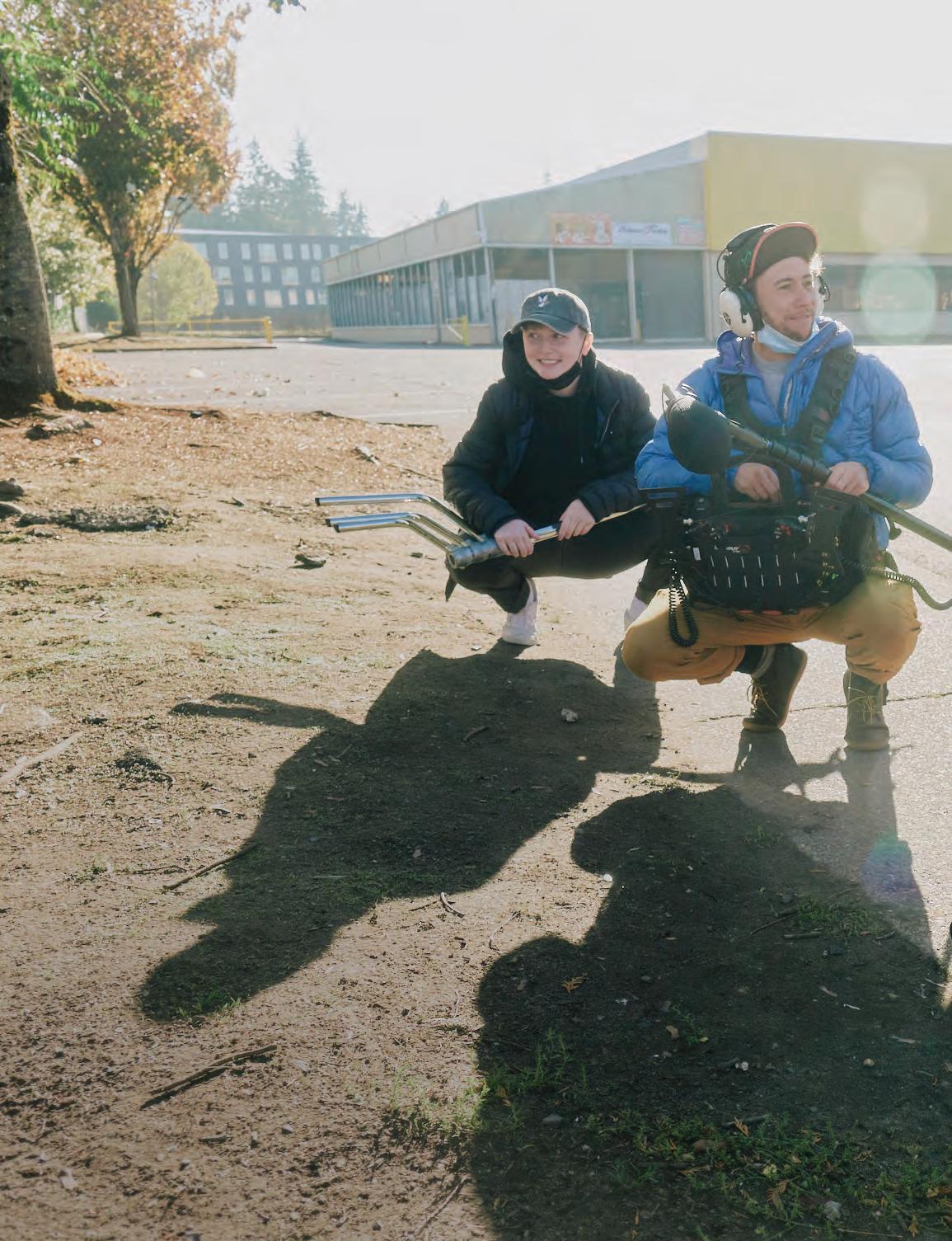 BY AMANDA WALDROUPE ’07
BY AMANDA WALDROUPE ’07
“All right, everybody,” Nili Yosha ’07 said. Around her a group of young actors snapped to attention. “Butts in seats. You’re eating lunch, you’re talking, you’re chilling.”
It was the second week of a two-week filmmaking intensive run by Outside the Frame, a nonprofit teaching filmmaking and storytelling skills to houseless youth.
That day, scenes for a short film were being filmed in the rec room of a social service agency for houseless youth in downtown Portland.
A half dozen young adults—aged between 18 and 25—goofed off during a lull. But at Nili’s instruction, they took their places. Chairs scraped as they sat at two tables. They played cards, ate lunch, and drank coffee while one youth filmed and another recorded sound.
As filming progressed, Nili stood in the back of the room, arms crossed. Much like a director or producer, she never took her eyes off of the youth. For the most part, though, she left the filming up to them. They were, after all, the directors and creators of this short film, and—she hoped the experience would remind them—the directors of their own lives.
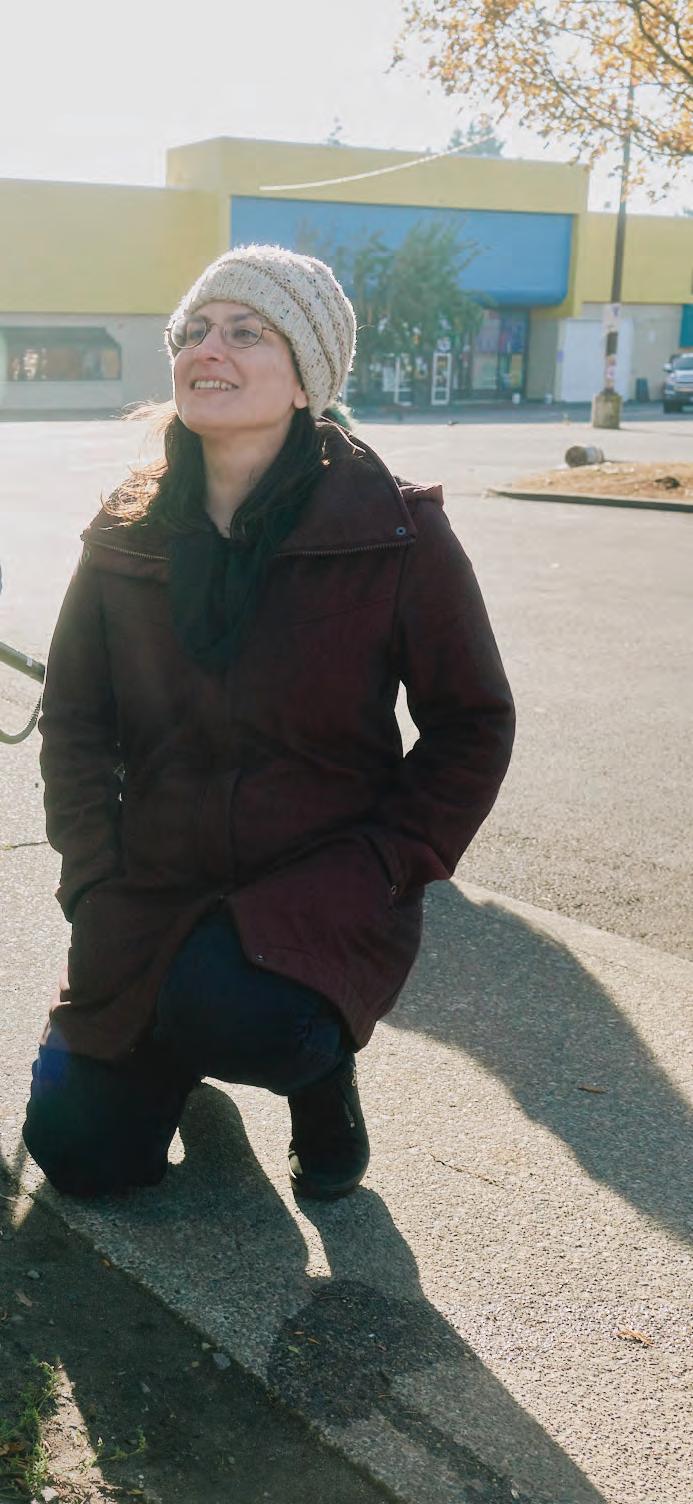
Nili is the founder and executive director of Outside the Frame, an organization that she built with the idea that houseless youth need more than just something to do and somewhere to be during the day. And she wanted to do more than provide an opportunity for houseless youth to pursue a creative outlet.
The ability to make art—to express thoughts and emotions through abstract expression—differentiates the human species from other mammals. If art makes us human, then Nili helps Outside the Frame’s young participants regain their humanity.
photo by mason trinca
15 Reed Magazine december 2022
Members of an Outside the Frame (OTF) production team on shoot day in September. From left: Kendyl, a first-time production assitant; Kai Tillman, mentor and audio engineer; and OTF founder and director, Nili Yosha ’07.
CHANGING THE LENS
The day after the filming in the rec room, I arrived at Outside the Frame’s offices, located on the third floor of Union Station, the historic terra cotta-roofed train depot in downtown Portland. Nili met me in the foyer. She almost immediately handed me off to Alex Blak, 22, a student in the intensive whom Nili asked to give me a tour.
Nili often does this: when I asked a question and a youth was nearby, she asked them to answer instead. It’s a strategy to help the youth feel a sense of empowerment and ownership in Outside the Frame (which she and the students call “OTF”).
The day was dedicated to editing the films made during late September’s filmmaking intensive. During OTF’s two-week intensives, participants learn everything needed to make short films: using a film camera, audio equipment, and other technical equipment, writing scripts, conducting interviews, acting, editing. The youth conceive, shoot, and produce all genres of film: documentaries, music and rap videos, telenovela-style dramas based on their lives, even horror films. “They decide the movies they want to make and what’s important to them to say,” Nili said.
Starting in the foyer, Alex led me through OTF’s spacious offices: an equipment room and a fully stocked kitchen off a short hallway, which opens to the main office space— a large, open room, with tables and chairs arranged in a rectangle, reminiscent of Reed’s conference-style classrooms.
There are couches and nooks for hanging out, relaxing. Lunch is delivered each day the youth are there. “It’s cozy,” Alex told me. A wall of shelves is filled with free dry food and medical supplies, and the shelves storing office supplies include fidget toys—small, handheld toys youth can play with when feeling anxious.
A large television, used to screen and edit films, stands at the far end of the room. As Alex showed me around, two film editors worked on a documentary called Talent in the Hood. In the film, two intensive participants interviewed houseless artists in downtown Portland about their art and creativity. The two filmmakers star in it, as well: one plays the guitar, another raps.
Alex led me through the room, into OTF’s administrative offices, then successively through a dressing/interview room, an editing studio, and a recording studio with the capability to film against a green screen.
Standing in the recording studio, she told me about the film she planned to make that week, a horror movie set in OTF’s offices. It is the third film she has made since joining OTF in October 2020.
“I’ve always been obsessed with film,” she said. In high school, she took a broadcasting elective each year.
During her senior year, in 2019, both her parents died. She moved in with stepfamily, whom she says were abusive. One month later, they kicked her out. Alex was houseless for nearly two years before a social service agency helped her move into an apartment. The same agency told her about Outside the Frame.
The first film she made is a documentary about her life, her family, and what led her to become houseless. The process forced her to put a chronology to her life and examine events in a way she might not have. “My life was more traumatic than I thought,” she told me. “It made me really think.”
Alex’s experience, Nili said, is not unusual. Filmmaking requires telling a story with a narrative an audience can follow. Stories must have a beginning, a middle, and an end; the ability to say this happened, then this happened, then this happened. Often, Nili said, the process of making a film helps the youth make sense of their lives, and allows them “to finally move on.”
It is estimated that 1,500 to 2,000 youth between the ages of 16 and 24 years are houseless in the Portland region, according to Portland and Multnomah County’s Homeless Youth Continuum. Teenagers and young adults become houseless for myriad reasons. Some are escaping abusive parents or untenable foster care homes. Others are kicked out by their families because of their sexual or gender identity. Young people who identify as LGBTQ are overrepresented among Portland’s houseless youth: some estimates put the number at well over 50%.
In their teens and twenties, many of OTF’s students wear drawn and worn expressions and look older than their ages. “They’re just staying above water,” Nili said. “It’s important to stay alive, but it’s not enough for you and me, right? We all want to thrive.”
When asked what they most enjoy about OTF, all the youth I interviewed gave a similar response: “I get to express myself.”
“You get so hung up on survival,” Joey Wander, Outside the Frame’s peer mentorship coordinator, said. “Where you’re going to camp that night, where you’re going to get food that day. You forget about creativity.”

Joey, a wheelchair user often clad in a jacket covered with patches and pins, fingered a fidget toy as they spoke of becoming houseless at the age of 17.
Joey is non-binary, and their sister outed them to their parents, “very much a vindictive thing,” they said. Growing up in a conservative, Christian family, Joey “was consistently reminded that my existence was abhorrent.” They were kicked out of their church’s youth group, then their church altogether, then out of their home after their mother saw them wearing a French tip manicure. “I don’t need this under my roof,” Joey remembered her saying.
Now 33, Joey spoke about what happened next in dualities, nuance, thoughtfulness—the same kind of distance and
16 Reed Magazine december 2022
perspective Nili says many of the youth need to tell the stories in their films. “That stuff was out of my control,” Joey said. “Then I made my own mistakes.”
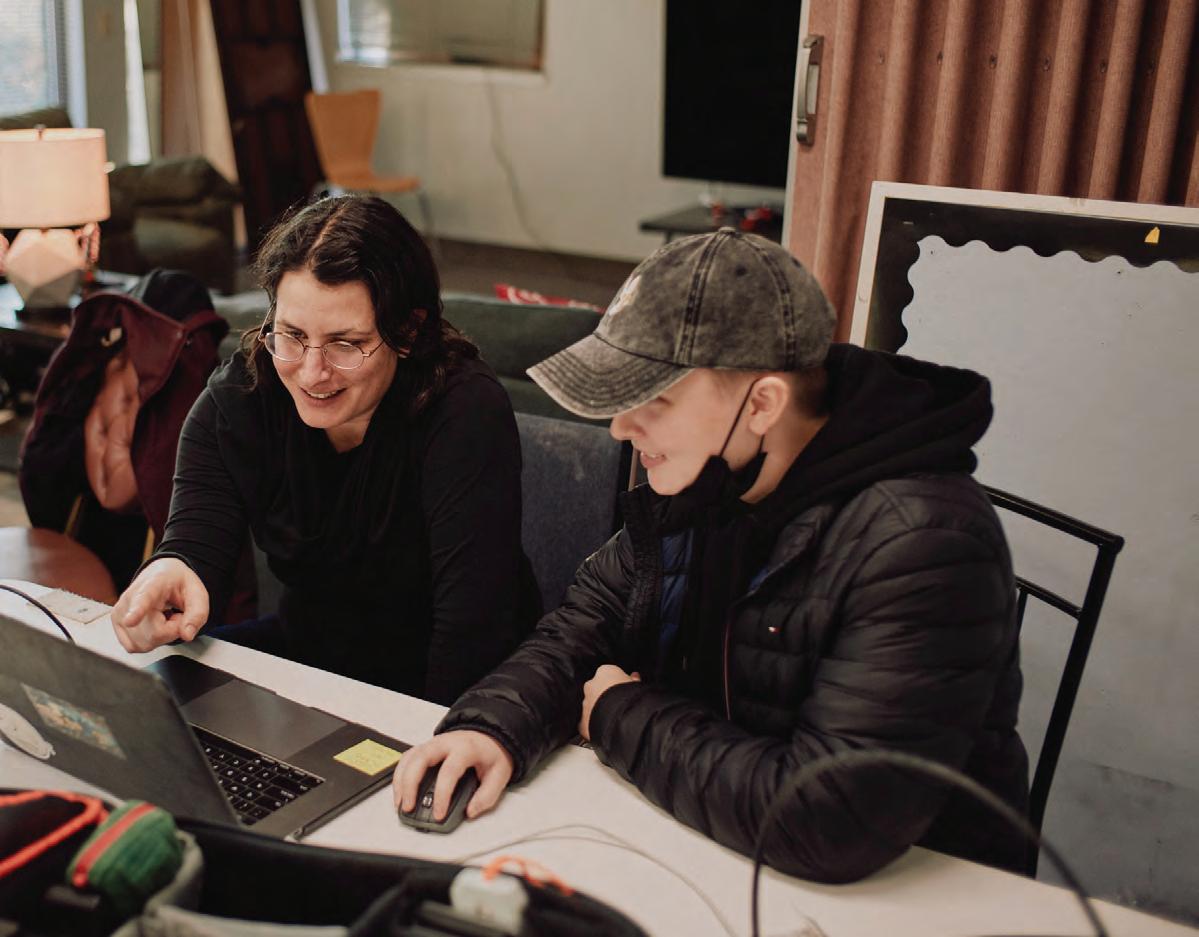
Three years of instability followed: Joey moved into an apartment with a friend, then started abusing opiate prescription drugs, which eventually led to their eviction and houselessness.
Wander’s participation in Outside the Frame coincided with a period in their life in which they found housing and a job, became sober, and rebuilt their life. As a child, they played guitar and wrote. One of Outside the Frame’s first participants, Joey said making films helped them “remember I could do art.”
“What do you mean ‘why’?” Nili shot back.
We sat on a park bench outside of Union Station on a sunny fall day. I had asked why she chose houseless youth as the group Outside the Frame would serve. Her response, I quickly found, was characteristic of her penetrating and irreverent intellect.
“It’s a crime against humanity, that’s why.”
“They’re so tough and awesome,” she said of OTF’s youth. When making their films, they show a degree of “vulnerability and bravery and willingness to face their shit” that Nili says is remarkable. “They look at themselves honestly in a way that most of us wouldn’t, or couldn’t.”
Art’s ability to advocate for and further social justice was instilled in Nili
throughout her childhood. She was born in Israel, and her parents, Yaki and Dorit Yosha, are among Israel’s most acclaimed filmmakers. They produced and acted in Israel’s first antiwar film, Shalom. The film was released in 1973, soon after the conclusion of the Yom Kippur War (also known as the October Arab-Israeli War of 1973). Her parents, Nili said, were certain that within weeks of the film’s release, peace would come to the Middle East.
That, of course, did not happen.
After high school, Nili refused to do Israel’s compulsory two years of armed service. Instead, she did a year of community service, working as a counselor in the political youth group Noar Meretz, the youth wing of an Israeli social democratic party.
Nili and production assistant Kendyl review footage at the end of shoot day. 17 Reed Magazine december 2022
photo by mason trinca
CHANGING THE LENS
During one meeting, the members were asked to envision “the ultimate humanist school.” She imagined a school with a beautiful campus, with small classes, engaged teachers, where grades didn’t matter, an egalitarian, trust-based community, where there were “people with brains that you could talk to, you know?”
When the Second Intifada began in 2000, Nili found herself making a similar decision to the one her parents had made years eariler: to leave Israel. She moved to New York City the day before September 11. “There are some things you can’t run away from,” she thought, reflecting on the political and social violence she had witnessed throughout her life.
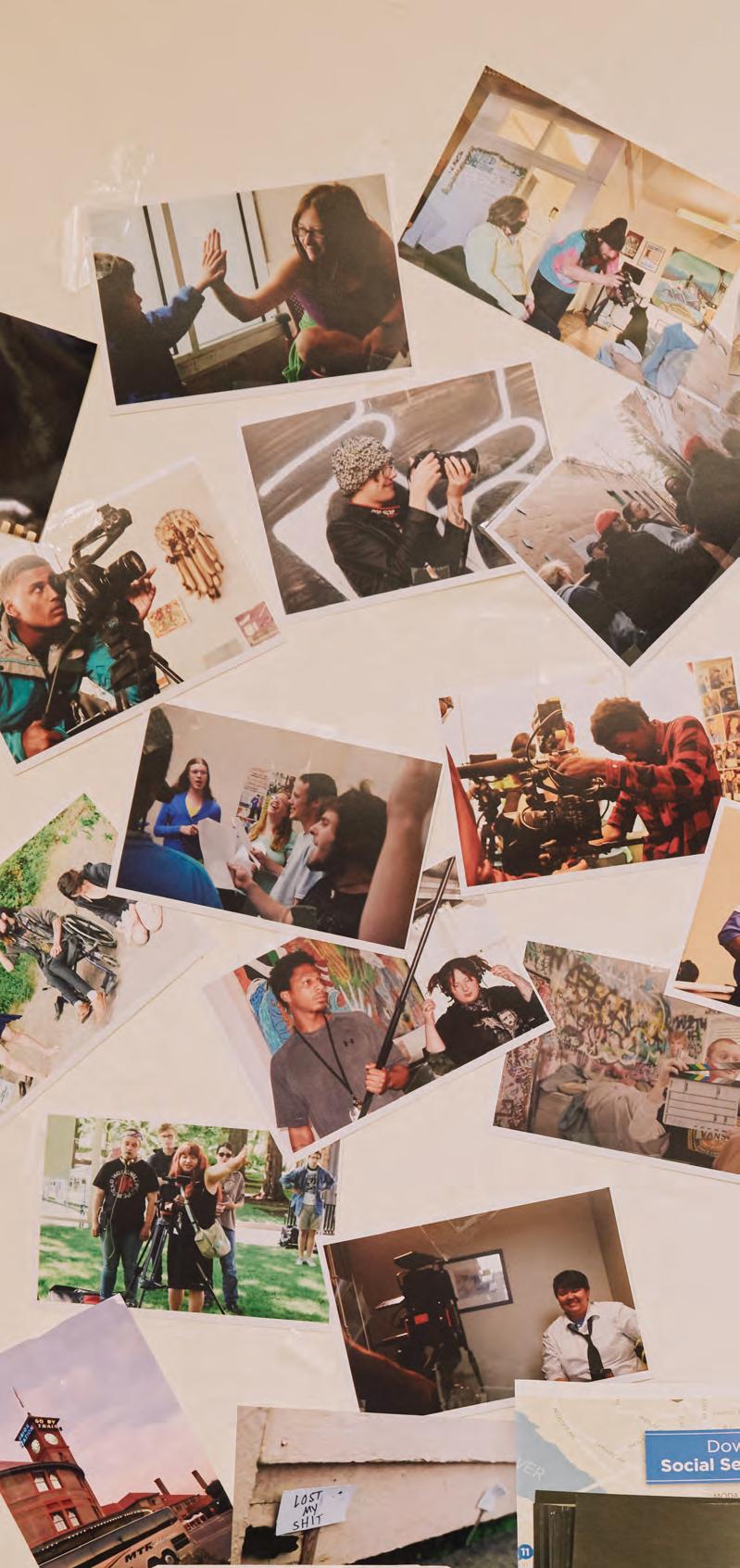
She left New York, and while living in Arizona with her godmother and figuring out what to do next, she spoke on the phone with an elementary school friend, Betsy Breyer ’05 . Betsy excitedly told her about the college she attended: Reed. “Why don’t you come?” she asked.
Nili arrived on Reed’s campus in September 2002, with “just me and Betsy and my suitcase.”

At Reed, it did not take Nili long to recognize the college she had dreamt of in the youth group. “This is my school!” she exclaimed.
One day, she encountered Prof. Geraldine Ondrizek [art] as she unloaded her car. Nili offered to help. Then, Nili heard a siren. Without thinking, she stood at attention. In Israel, sirens are sounded for two minutes
Nili and Betsy Breyer ’05 dressed for Halloween in 1993.
trinca 18 Reed Magazine december 2022
A collection of photographs taken by participants during past OTF workshops. photo by mason
Selected Films
Since its founding in 2015, Outside the Frame (OTF) has produced 100 films—and counting. Here are six to get you started.

Riders on the Storm 2021
Last Dayz 2021
An intimate look at how public servants worked against all odds to help their houseless neighbors— and ultimately failed during the COVID-19 pandemic and Oregon’s 2020 wildfires. Made in collaboration with Metro, the film led to funding for more outreach teams at this regional government agency.

SwitchUp 2020
One of five music videos produced with Mic Crenshaw, Friends of Noise, and Portland Public Schools. In it, young artist Stunnaboii.Z raps over footage from the 2020 protests in Portland. OTF is in its fifth year of collaborating with Portland public alternative high schools, where the number of housing insecure-students is rising.


Hairapy 2017
A music video in which a young rapper, King, confronts his dad’s drug addiction in a way he was unable to in real life. The film was produced during a workshop at Alliance High School at Benson. Students directed, acted, and filmed; hip-hop artist and Portland Public School educator Mic Crenshaw produced the song.
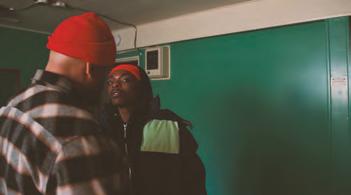
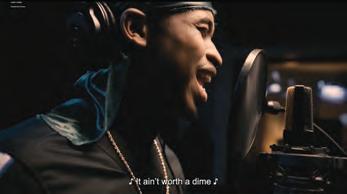
Inside the Frame 2017
One of OTF’s first participants, Jacob, told Nili he needed a haircut before his mother’s funeral. Nili took him to her hairdresser and brought a camera, just in case. Hairapy is the result. The film recently screened in Venice as part of the closing events of the European Cultural Centre’s 2022 Personal Structures exhibition.

Vicious Cycle 2017
A documentary that follows OTF participants in a summer workshop as they produce an original song, “Inside the Frame.” Through a series of interviews, students explore their lives and houselessness. Unity, one of the young artists, notes, “It’s not that I left home, it’s that I left my situation for something that could be better.” More at outsidetheframe.org/films
A silent narrative film about the vicious cycle of poverty and disadvantage in which youth are caught. The film was the result of a discussion at a film intensive about exploitation of and within the homeless community.
on Holocaust Remembrance Day and other important holidays. Citizens—no matter where they are or what they are doing— stand at attention, Nili said, “and remember.”
“It’s a train, Nili,” Ondrizek said. “It’s okay.”
“Coming from Israel,” being 20 years old and a non traditional student, “it was nice to have a Jewish teacher that gets it,” Nili said.
She “gravitated toward the art department,” but steered far from her parents’ legacy. “I wanted to sculpt naked women,” Nili said. “From marble.” She took an independent course on stone sculpting from Ondrizek, who gave her “the worst grade ever.” Nili eventually became interested in photography. “I was gonna be different than my filmmaker parents. Only one frame per second.”
Nili took her first photography courses in Reed’s art department and transferred to the San Francisco Art Institute to finish her undergraduate coursework. (Prof. Lena Lencek [Russian literature and humanities 1977–2022] edited Nili’s artistic statement numerous times, sending it back, Nili remembered, “covered in red ink.”) She stayed in San Francisco for graduate school, earning a master’s in comparative literature. Then, during an utterly mundane moment, her life took a turn.
One day, as she walked down the sidewalk, a poster taped to a window caught her attention. It showed the decline in federal dollars used to build and subsidize low-income housing, cut by more than twothirds in the mid-1980s, from a peak in 1978. Contrasted with the decline was an equally steep increase in homelessness.
Nili was transfixed.
She found herself in a “historic red building”—the offices of the Western Regional Advocacy Project (WRAP), an organization advocating for the civil rights of houseless people. She met the executive director and asked how she could get involved. He explained that WRAP was protesting a proposed city ordinance to segregate houseless and housed children into separate schools. They needed a poster. He asked Nili, “Did I have any art?”
Homeless Go Home was Nili’s answer. In it, a child carrying a stuffed backpack walks down a sidewalk, presumably to school. He is flanked by national guards, recalling Norman Rockwell’s painting of Ruby Bridges, The Problem We All Live With. Like her, he passes a wall of graffiti. The black letters read, HOMELESS GO HOME.
But where is home? The child, wearing shorts and a t-shirt, and with a backpack, was not obviously houseless. Or was he?
The proposed ordinance failed. The experience made her realize “one frame wasn’t enough”—that an artistic medium allowing for more complexity was necessary to tell the stories of houseless people.
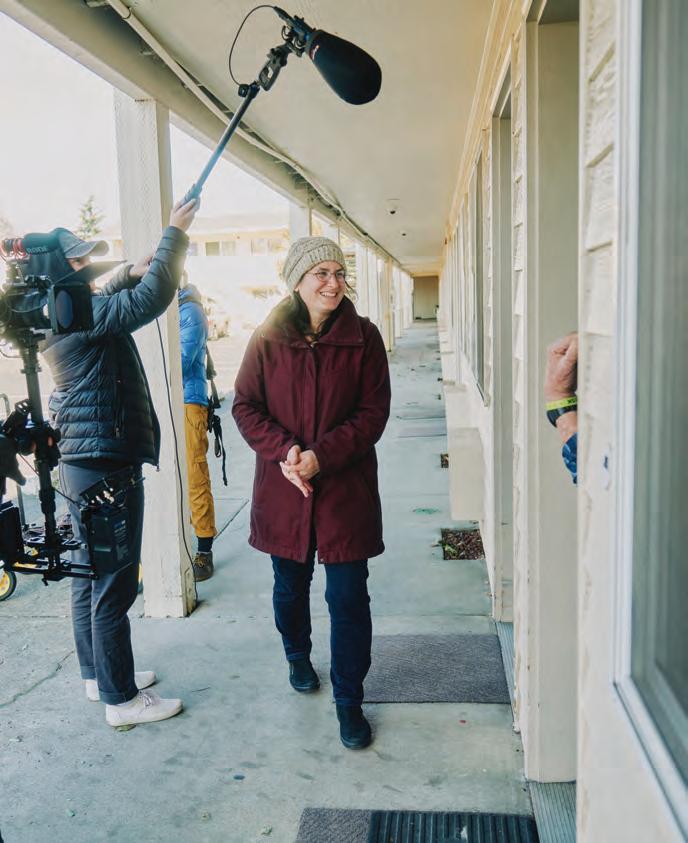
She moved back to Portland, landing a job at a social service agency working with houseless youth. “When I came back to Portland, I was like, there’s teenagers living outside, and it’s raining and cold,” she remembered. “You walk around the neighborhood, and you want to cry.”
She also met and married her wife, whom she met through Miriam Jagle ’06. The couple have two children, whom they wanted to grow up seeing “their parents doing what they’re supposed to.” Thinking of the houseless youth to whom she had grown fiercely
loyal, Nili wondered, “What can I do with them that’ll matter to them and show the world how amazing they are?”
The answer, by then, was obvious. “You can’t escape your destiny,” Nili said dryly. “Movies was it.”
Nili founded Outside the Frame in 2015. In its first year, it produced 13 movies—an astounding output. “We didn’t know it was impossible,” she said. When it came time to screen the films, she remembered a vow she had made the summer before.
She had taken a group of houseless youth to the Portland Art Museum on a day offering free admission. When they met back up, Nili asked what they thought of the museum. One youth responded, “we were followed around by security the whole time.”
CHANGING THE LENS
photo
20 Reed Magazine december 2022
The OTF team onsite to interview residents of a motel-turned-emergency shelter, part of a project for Multnomah County’s Joint Office of Homeless Services.
by mason trinca
“Next time you walk in here,” she promised them, “it’s going to be on a red carpet.”
Outside the Frame’s first films were screened at the Portland Art Museum’s movie theatre, the Whitsell Auditorium. Before the screening, Nili went to a carpet store. “I was like, ‘You got any trim?’” Much like the Reed seniors who walk through the library during Renn Fayre, OTF’s students walked into the Whitsell on a red carpet.
The second year, OTF “honed it in” and made only six films. The third year, OTF made a feature-length film, The Lost Boys of Portlandia, a retelling of Peter Pan from the point of view of street kids.
The organization quickly expanded from offering only two-week intensives to hosting workshops and open labs twice a week. Instead of restricting programming during the COVID-19 pandemic, OTF expanded.
Films have reached international audiences: most recently, five were screened in Venice as part of an art exhibit Ondrizek invited Nili to participate in (see “Change
kids,” holding them to the “highest standards, pushing the envelope and seeing their potential and their best selves.”
“Reed expects so much from undergrads,” Nili said. “That attitude is the same spirit of what I do at Outside the Frame.” She tells the youth: “Yeah, you’re living outside. Yeah, all the odds are against you. Yeah, people think you’re less than nothing. But not in here. Let’s make some movies. What do you got to say?”
A lot. No matter the genre—documentary, music video, drama—the aesthetic, which Nili calls “OTF style,” is one of deep humanity, the stories simultaneously intimate, provocative, and raw.
“I just can’t get over the fact that I’m allowed to do what I want in my space,” one student says, reflecting on living in a new apartment, in a documentary about their life. Super Queer Force: Miss Gendering is farcical, yet almost heartbreaking. In it, a group of queer superheroes, similar to the Care Bears, appear and use their superpowers to ban-
white button-down shirt and khaki pants. The pant legs were cuffed. “It’s casual looking,” he said. “I’m not used to wearing formal pants.” He cuffed them a second time. “No,” Nili said. “It’d be too short.”
He unrolled them entirely. “Does that look good?” he asked.
Nili suggested cuffing the pant legs once. “It looks better and you’ll feel more comfortable,” she said. She ran to her office and returned with a business card. “You can list us as a reference. Go get ’em.”
Many of OTF’s alumni have gone on to get short- or long-term jobs in Portland’s film industry. They work as production assistants, in wardrobe departments, and even as camera operators. For others, participating in OTF gives them the motivation and confidence to finish high school, test for a GED, apply to college, or jump through everexpanding hoops to find permanent housing.
Joining Outside the Frame, Alex said, “resparked everything.”
“I had a really low point and was depressed,” she said. “Film helped me pull out of that.” Now she is working to finish her high school degree and apply to college.
“When these kids are on stage premiering their film to a full house who’s giving them a standing ovation . . . they won’t see themselves the same anymore,” Nili said.
Agents,” September 2022). During a symposium about the exhibit in late September, many viewers were touched by Nili’s determination to “honor their minds and their hands and their creativity, because that’s actually what will make you a human being,” Ondrizek said.
After taking Hum 110, Nili said she “was not afraid to read any book.” She brings that same doggedness and fearlessness to being the executive director of a nonprofit. “She is an unstoppable force of a person,” Joey said.
When OTF made Lost Boys, Nili applied for a grant from the National Endowment of the Humanities. Lencek provided a recommendation letter. She wrote of Nili, “I see in her the combination of steely determination, idealism, pragmatism, and sheer talent that is the formula of success.”
OTF didn’t get the grant, but Nili keeps the letter in her office. “It’s the kind of letter that you pull out in the dark night of the soul,” she said.
“She saw stuff in me before I did,” Nili said of Lencek—and of her entire Reed experience. “That’s what I try to do with these
ish binary pronouns after the filmmaker is misgendered in a grocery store.
There is something radical, even subversive, about showing films narrating the life experiences of the houseless, young filmmakers in Portland’s most elite artistic venues.
“The best way to change a person’s mind is the interaction with the fellow human being. The next best thing is a piece of art that moves them. We provide both, together,” Nili said. “Film is an emotional medium. [Viewers] feel something, which is the only way to change anyone’s mind.”
The editing of Talent in the Hood continued into the afternoon. Indian food was served for lunch. Students ate, checked their phones, looked on as the editors worked.
While the editors worked on the intro track, Nili watched, and noted the beginning lagged. “Give me the best stuff up front,” she said.
A youth walked up to Nili to tell her he was leaving for a job interview. He wore a
That proved to be the case with one of the intensive’s students. On Friday, October 21, the rough cuts of the films were screened. None of the scenes from the rec room made it into The Same Things Happening to Me All the Time. The silent film cut between different moments in the filmmaker’s life: hanging out with their friends at a playground; in the evening, spreading out an issue of the Portland Tribune with the headline “Homeless Not Heartless” on the cover before lying down to sleep next to a brick building; then scenes of them in a new, nearly unfurnished apartment. Then the film showed images of the apartment vandalized, the walls covered in inked graffiti and stains. The filmmaker’s former partner caused the damage.
The assembled youth applauded after the film finished. Afterward, Nili said making the film helped the filmmaker “face what happened, take responsibility,” and help the landlord clean the apartment.
“If houseless youth can make movies,” she said, “they can do anything.”
21 Reed Magazine december 2022
“Film is an emotional medium. [Viewers] feel something, which is the only way to change anyone’s mind.” —Nili Yosha ’07
Reediana
Books. Music. Film. Send us your work!
EDITED BY ROBIN TOVEY ’97 Email reed.magazine@reed.edu
Documentaries and Serendipity: America’s Most Dangerous Producer Surviving Twisted News, Power, Greed and Craziness
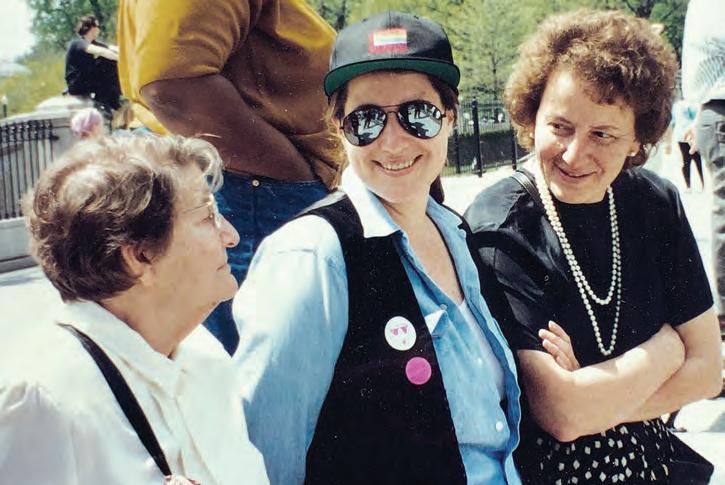

Prolific filmmaker Robert Richter ’51 has published a rich autobiography in which he reflects on his life as a fearless journalist and creator of provocative films, including several that received Academy Award nominations. Since 1968, he has made more than 50 films, including an exposé about the sale and distribution of harmful pesticides (its screening led to the establishment of an international monitoring system) and The Last Atomic Bomb, which profiles a Nagasaki survivor and explores the connections between her story and modern nuclear-proliferation issues. Robert began his career at Oregon Public Broadcasting and the New York Times, covered U.S. national politics with Walter Cronkite and other notable journalists at CBS, and ultimately became an independent investigative producer who took great risks to cover underreported global topics. (Independently published, 2022)
Precepts, Ordinations, and Practice in Medieval Japanese Tendai
Precepts, Ordinations, and Practice in Medieval Japanese Tendai i s a landmark collection of essays by Paul Groner ’68, one of the leading authorities on Tendai Buddhism. It examines the medieval Tendai School, which dominated Japanese Buddhism at that time, to uncover the differences in understanding and interpreting monastic precepts and ordinations. Rather than provide an unbroken narrative account—made virtually impossible due to the number of undated apocryphal texts—Paul employs a multifaceted approach, focusing on individual monks, texts, ceremonies, exegetical problems, and institutional issues. Many of the issues discussed in the volume, particularly how to distinguish various types of Buddhist practitioners, continue to preoccupy Tendai monks centuries later. ( University of Hawai‘i Press, 2022)
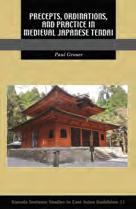
The Ivy Hero: The Brave Life of Sergeant William Shemin
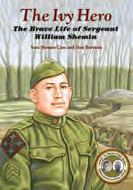
Dan Burstein ’73, author of 14 nonfiction books, has written his first for children, together with his cousin Sara Shemin Cass. This book tells the story of Sgt. William Shemin’s adventurous life and serves as a clarion call to young people, as well as adults, to join the fight against discrimination and intolerance of all types. William Shemin, the authors’ relative, was a World War I hero who fought bravely for America on the battlefields of France in 1918, but he was denied a Medal of Honor because he was Jewish. It also tells the similar story of Henry Johnson, an African American soldier who was also a hero of 1918 and was similarly denied a Medal of Honor because he was Black. President Obama awarded both men posthumous medals in 2015. (City Point Press Kids, 2022)
No on 9 Remembered
Holly Pruett ’85 is authoring the digital remembrance project called No on 9 Remembered Revisiting Oregon’s epic ballot measure fight to defeat the anti-LGBTQ Measure 9, the multimedia project tells 30 stories from 30 years ago—stories of people, places, actions, and events—each offering a prism through which to understand the past. “This is not an archival project. It’s a project devoted to historical memory. To the stories we carry within us.” During the No on 9 campaign, Holly was executive director of the Oregon Coalition Against Domestic & Sexual Violence, and she served as primary organizer and then deputy campaign manager for the campaign to defeat Measure 13 in 1994. Other Reedies, including Kathleen Saadat ’74 and Tarso Luís Ramos ’93, have been involved in this project. See noon9remembered.org.
Editor, speaker, teacher, and now children’s book author, Monica Wesolowska ’89 has written her debut picture book for young readers, Leo + Lea Illustrated by Kenard Pak, it is a story of math, art, and friendship, with words that follow the Fibonacci sequence. For more than 15 years, Monica has taught creative writing at UC Berkeley Extension, Stanford Continuing Studies, Left Margin Lit, and elsewhere around the Bay Area. Monica offers this full-circle appreciation: “I got the idea for this story 13 years ago, when my oldest son was in kindergarten, and he left for college this fall (yes, 13 is a Fibonacci number!).”
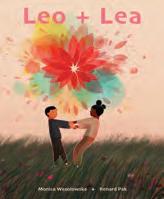
(Scholastic, 2022)
My Heart Has No Home
A narrative of mourning and healing by John Worsley ’92, My Heart Has No Home, provides a moment-bymoment account of his grief after his wife, Amy Heil ’92, died suddenly at age 50. What started as short posts on Facebook turned into a longer blog, “driven by the simple thought that we don’t talk much, in our daily lives, about what it’s really like to lose a loved one,” he says. “My posts came to encompass the specific ways grief was hitting me, as well as what I was learning and how I was healing. I tried to be as honest as I could, sharing my pain and flaws as well as Amy’s, and how those interacted in our marriage.” (Together Editing Press, 2022)
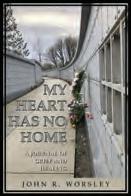
22 Reed Magazine december 2022
Leo + Lea
Holly Pruett ’85 (center) at the 1993 March on Washington for Lesbian & Gay Rights with her mother (right) and grandmother, an anti-fascist WWII émigré from Italy.
Vijay Shah ’93 edited Man on a Mission, a historical comic book about civil rights that tells the story of James Meredith, who famously desegregated the University of Mississippi (a.k.a. Ole Miss) in 1962. The book depicts Meredith’s relentless pursuit of justice, beginning with his childhood in rural Mississippi and culminating with the confrontation at Ole Miss. “A blend of historical research and creative inspiration, this graphic history tells Meredith’s dramatic story in his own singular voice.” (University of Arkansas Press, 2022)
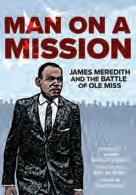
The Cartoon Introduction to Climate Change, Revised Edition
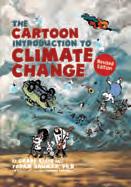
In his latest book, Yoram Bauman ’95 delivers a unique and enjoyable presentation of mind-blowing facts and critical concepts. Everyone from students to policy makers can learn about everything from Milankovitch cycles to carbon taxes. This instructive volume is based on reports from the authoritative Intergovernmental Panel on Climate Change (IPCC), and if that sounds dry or daunting, consider that he and coauthor/illustrator Grady Klein have already published two successful cartoon guides to economics, “making this notoriously dismal science accessible to countless readers.” Yoram has a PhD in economics and has taught at both the high school and college level; he now spends his energy performing at comedy clubs, universities, and conferences and pushing policy rocks up the hill (see Class Notes). (Island Press, 2022)
Enabling Mathematics Learning of Struggling Students
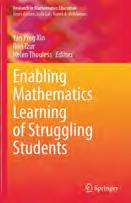
Helen Thouless ’95 has coedited a book for prospective and practicing teachers. This researchbased volume, co-edited by Yan Ping Xin and Ron Tzur, contains chapters cowritten by mathematics education and specialeducation teachers from around the world, all of them aiming to present teaching practices that will support the development of the mathematical conceptual understanding of children struggling to learn. Thouless has taught in London and Seattle, and she currently teaches mathematics as a senior lecturer at St. Mary’s University, Twickenham, in England. While teaching she has held a variety of roles, including mathematics specialist, inclusion teacher, and special-education teacher. (Springer, 2022)
Hog Haven

Christopher Beeson MALS ’98 is a documentary filmmaker whose most recent feature profiles an animal sanctuary in rural Colorado, explores the work of large-animal rescue organizations, and promotes animal advocacy and plantbased lifestyle choices. The film was broadcast on PBS stations nationwide beginning in August, and throughout the fall live screenings and Q&A panels were held with various animal-law programs and at colleges and universities. Christopher is currently the program manager and instructor for the film and television department at the University of Colorado, Denver.
(See hoghavendoc.com)
Managing the Whole Student Life Cycle
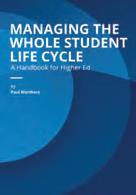
Paul Marthers, MALS ’05, vice provost for enrollment management at Emory University, has written Managing the Whole Student Life Cycle . This handbook for higher-education professionals offers an integrated, whole-campus approach to boosting retention and graduation rates. Each chapter reviews practical approaches that have demonstrated success at varied institutions, offering worksheets to prompt thinking and suggesting practical next steps. Marthers brings to the topic more than 25 years of experience and expertise, including seven years as the dean of admission at Reed. (Academic Impressions, 2022)
Recoding Power: Tactics for Mobilizing Tech Workers

Jamie Isenstein: Spectacle
Gluck50, an art residency and exhibition space in Milan, Italy, has published Jamie Isenstein: Spectacle, a catalogue on the occasion of the artist’s exhibition “Spectacle.” The volume documents artwork Jamie Isenstein ’98 created and exhibited at Gluck50 in 2017. A comprehensive essay by curator Nicola Trezzi on her work and the exhibition is also included. In addition, a supplementary photo essay by Jamie on looking devices, spectacles, spectators, and the question of what makes the body an object is included in the catalogue. (Gluck50, 2022)

Stuck?: Diagrams Help
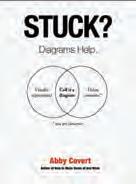
Jenny Benevento ’01 researched and indexed the book called Stuck?: Diagrams Help , which includes her literature review about the history of diagrams. The book is by information architect Abby Covert, and it has been described as “a field guide for the trek from diagram novice to diagram nerd.” A passionate librarian and taxonomist, Jenny is the owner of her own metadata and content company. Her interests are in knowledge organization, thesaurus construction, and taxonomies; she says, “ Seriously, I think about this stuff when I am sorting my M&M’s by color.”
(Day Moon Sky, 2022)
Does digital transformation make worker power impossible? In Recoding Power: Tactics for Mobilizing Tech Workers, Sidney Rothstein ’09 considers this question in light of rising inequality and argues that worker power is possible in 21stcentury capitalism, outlining tangible ways in which workers can resist precarity. Tracing how workers respond to mass layoffs at four tech firms in the United States and Germany, he shows that workers can build power when they put workplace discourse and political creativity at the center of their collective action. Sidney is assistant professor of political science at Williams College. He has published in the British Journal of Industrial Relations, Review of International Political Economy, and Studies in American Political Development, among others. (Oxford University Press, 2022)
Talli: Daughter of the Moon, Volume 1
The latest project from François Vigneault ’13 is a sweeping narrative by the French-Laotian cartoonist Sourya, with letters and translation by François. This immersive YA adventure tale was inspired by Japanese role-playing games, and François lauds it as “an old-fashioned and engaging epic fantasy manga.” (Oni-Lion Forge Publishing, 2022)

23 Reed Magazine december 2022
on a Mission
Man
Class Notes
These Class Notes reflect information we received by September 15. The Class Notes deadline for the next issue is December 15.
Class Notes are the lifeblood of Reed Magazine.
While a Reed education confers many special powers, omniscience is unfortunately not among them; your classmates rely on you to tell us what’s going on. So share your news! Tell us about births, deaths, weddings, voyages, adventures, transformations, astonishment, woe, delight, fellowship, discovery, and mischief.
Email us at reed.magazine@reed.edu. Post a note online at iris.reed.edu. Find us on Facebook via “ReediEnews.” Scribble something in the enclosed return envelope. Or mail us at Reed Magazine, Reed College, 3203 SE Woodstock Blvd, Portland OR 97202. Photos are welcome, as are digital images at 300 dpi. And don’t forget the pertinent details: name, class year, and your current address!
EDITED BY JOANNE HOSSACK ’82
1951
Robert Richter has published a book about his career as “America’s most dangerous” filmmaker. (See Reediana.)
1953 70th reunion
Abbott and Costello meet Dr. Jekyll and Mr. Hyde.
1954–58
How about those Cincinnati Redlegs?
1959
Congratulations to Terence Kuch, winner of the 2022 Older Writers’ Grant from the Speculative Literature Foundation. Terence received the grant for his work “Westers.” Terence’s fiction, poetry, humor, and creative nonfiction have been published in nine countries, appearing in numerous periodicals, and have been anthologized in books from Random House and other publishers. He has survived interviews by the New York Times and USA Today. His novels, story collections, plays, and other writings are available on Amazon. Terence spent 52 years in the computer industry, finally retiring from the World Bank after assignments in Washington, D.C. and working with local staff on World Bank computer systems in three African countries. He now lives in Springfield, Virginia, with his wife and a
varying number of fostered cats. He has two daughters, one son, and six grandchildren. The Older Writers Grant is awarded annually to writers who are at least 50 years of age at the time of application to assist such writers who are just starting to work at a professional level.
1960
Anita Cramer Makler ’61, Harry Makler ’58, and Judy Larson Slager discovered they were all living at the Maravilla senior living community in Santa Barbara. So they got together for dinner there, brought old yearbooks, and had a great time reminiscing.


1961–62
World (well, Downey, California) welcomes Taco Bell.
1963 60th reunion
After spending all his summer (and some winter) breaks at his pied-à-terre in the Paris area for the last 20 years, Stanley Levine is now retired and living in France permanently. A bit over a year ago he moved south to a village in the Gard, where he expects to stay for the foreseeable future. This is less than an hour from the Université Paul-Valéry (Montpellier), where Stanley studied after graduating from Reed. Southern France is the area
of the indigenous, endangered language Occitan, which has been the subject of much of his research. Two months ago Stanley took his fifth trip to Tunisia, a splendid country with wonderful, gentle, and friendly people. On the trip back, he caught COVID and was laid low by it, but is now mostly recovered. Stanley would be glad to hear from any Reedies in his area, or digitally from anyone who remembers him from Reed.
1964
Harold (Skip) Bassford has been appointed a Member of the Order of Canada. The Order of Canada is one of Canada’s highest civilian honors. It recognizes “outstanding achievement, dedication to the community and service to the nation.” Skip received this honor “for his leadership as a university administrator and for his contributions to applied ethics in the health field.” Skip’s work to make philosophy and philosophical ethics relevant to professional and daily life began when he took Hugo Bedau’s [philosophy 1962–66] ethics class, and was inspired by Bedau’s successful fight against the death
Left to right: Judy Larson Slager ’60, Anita Cramer Makler ’61, and Harry Makler ’58 reminisce over dinner and yearbooks.
24 Reed Magazine december 2022
Phil Pincus ’69 and wife AbiGail at the end of the Camino de Santiago.
penalty in Oregon. He says the class was a great start to an active and fascinating academic career as a professor and university president in Canada.
1965
Peter Dodd recently moved to the D.C. area.
1966–67
Did you know that December is National Write a Friend Month? And that you can update many friends at once with a class note?
1968 55th reunion
The day after the pandemic shut down Toronto, Susan Eckenwalder started Covid, a beaded snake who, over 161 days of being fed two beads at a time, grew to 36 feet long. His adventures were shared daily in an email thread that eventually became The Life and Times of Covid the 19th When he finally escaped into the garden to seek a soulmate, Corona burst into life. She, too, grew to 36 feet. They were finally united, along with paintings by their creator, in a four-person show, Side by Side, at the Neilson Park Creative Centre in March.
Paul Groner has published a book on medieval Japanese Tendai Buddhism. (See Reediana.)
Peter Langston writes, “Reading John Cushing’s note in the 1967 class notes section of Reed v101 #2 [June 2022] made me think of my band, 3 Play Ricochet, and the sad fact that we haven’t performed or even really rehearsed in two and a half years. But we have managed to assemble an online performance or two by merging cellphone videos of us playing our parts. For example, our first experiment is a performance of my dobro instrumental ‘Mango Moon,’ visible on my website at www.langston.com/#MangoMoon. Right above it on that web page is my attempt at merging cellphone videos of me singing and playing banjo, mandolin, guitar, and bass in an homage to bluegrass musician Smiley Hobbs.”
1969
Over the last few years, Phil Pincus has walked a number of routes of the Camino de Santiago, a collection of pilgrimage routes ending in Santiago de Compostela in northwestern Spain. “My wife, AbiGail, and I have traveled through the Spanish countryside on walks of between 100 and 700 miles, always beautiful and uniquely spiritual; along the way we have befriended pilgrims from all over the world. For a different adventure, our coming journey is aboard an exploration cruise ship along
the fjords of Chile, to Patagonia, and to Antarctica, critical to see before the ice melts away.”
1970
Nixon commissions new uniforms for White House guards, featuring doublebreasted white tunics trimmed with gold braid, gold-trimmed black pants, and tall, stiff hats with the White House crest, overall looking oddly like high school band uniforms.
1971
Daniel Barraza hopes that this account of his career might help some Reedies majoring in mathematics: “I do not claim to be a visionary. I was lucky. I went on to get a PhD at the University of Colorado, Boulder. My thesis advisor, Karl Gustafson, got his PhD from Maryland and did some important work for the U.S. Navy. The University of Colorado built a large engineering center, with the ambition to become worldrenowned. The math department was very heavy with applied mathematicians. I was lucky to get an applied mathematician for a thesis advisor. He taught an interdisciplinary math-physics class. I saw graduate students from other disciplines there. This
education in applied math helped me later get a job in radar at Hughes Aircraft. The medical plan was very generous. Although my wife was seven months along when we joined the company, the company covered all maternity bills. There were no copayments. Babies were free, even the first one. My wife went on to have five. The truth is that I went to Colorado to hike in the summer and ski in the winter. It turned out to be a great career move.”
Sara Patton and a small group of mostly class of 1971 folks from NYC, Seattle, and Portland assembled in Portland at the Zenbu Lounge for sushi and nostalgia on July 29.
1972
Donald Macmillan Love ’71 and Kathryn Such Love celebrated “100 years of wholly acrimony” on May 23, 2022 (that’s 50 years of marriage for each).
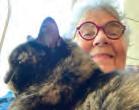
Niece Anya Such Ronshaugen ’99 and daughter Hannah Love, who attended Reed for a semester in 1994 to study astrophysics, helped organize the celebration in the Adirondack Mountains in July. Don and Kathy met at Reed in 1970.

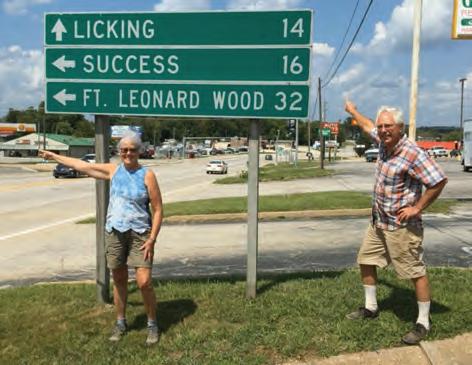
clockwise from top left Which way? Kathryn Such Love ’72 and Donald Macmillan Love ’71 in 1972 and 2022.
They braved Portland’s heat wave to get together outdoors this summer! Left to right: Tim Rowan ’71, Patti Macrae ’71, Katie Pool ’70, Matthew Kangas ’71, Jas Adams ’71, Jaynie Gaynor ’71, Marge Goldwater ’71. Inset: Sara Patton ’71, the photographer, and Tootsie, her tortoiseshell.

Together at last! Beaded snake soulmates Covid and Corona, created by Susan Eckenwalder ’68, meet at the Neilson Park Creative Centre in Toronto.
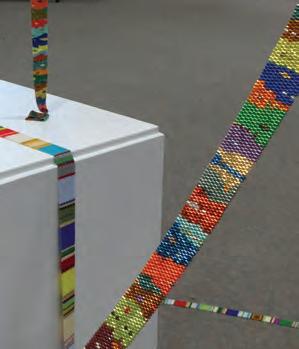
25 Reed Magazine december 2022
1973 50th reunion
Dan Burstein, who attended Reed 1969–70 and is the author of 14 nonfiction books, has collaborated with his cousin, Sara Shemin Cass, to write his first children’s book (See Reediana.)
Jayne Loader is relocating to Pasadena with her husband, Robert Kirshner, the new Executive Director of the Thirty Meter Telescope International Observatory (TIO), to be built—hopefully!—on Maunakea on the Big Island of Hawaii. The job (widely regarded as the hardest in astronomy!) comes with a Caltech appointment and a sweet little Craftsman on South Catalina. Jayne is looking forward to reconnecting with old classmates and friends, especially Marcia Yaross, Loraine Shields ’74, and Jane Neff Rollins
1974
Laser printer and inkjet printer invented, though not yet used to print Reed theses (if we’re wrong, write to us) (write to us anyway, OK?).
1978
45th reunion
Chris Hall’s custom Factory Five GTM Gen 1 supercar, named Cruz Rockit, showed at Monterey Car Week’s Exotics on Broadway in Seaside, California, on August 2. This (barely) street-legal race car/custom car/hand-built exotic/ lifelong dream car creation was professionally team built, tuned, and developed with his vision, design, engineering, and problem-solving skills May 2008 through the present. Debuting at GoodGuys 34th Annual West Coast Nationals in Pleasanton, California, on August 27, the car won the All American Sunday Award.

1979–82
Long-retired Nixon-commissioned White House guard uniforms purchased by Meriden-Cleghorn High School in Marcus, Iowa, for marching band.
1983 40th reunion
A few new words: carbo-load, FLOTUS, shareware.
clockwise from top left Old Reedie friends with partners at their last supper together, in (yikes!!! says Jayne) May 2017. Back row, left to right: Dan Rollins, Jane Neff Rollins ’73, Loraine Shields ’74, Jayne Loader ’73, and Robert Kirshner. Front row, left to right: Marcia Yaross ’73 and Bill Bertonneau.
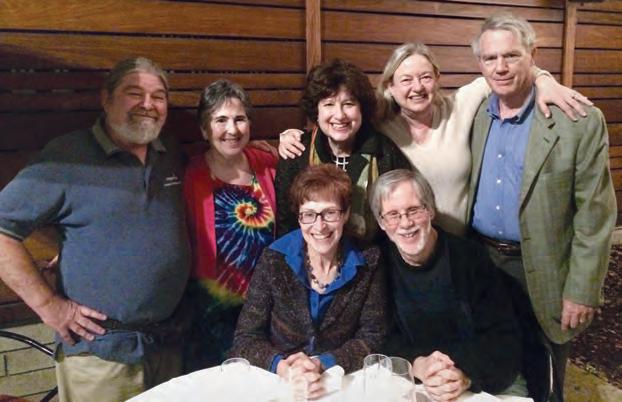
An update from Xander Twombley ’87. Chris Hall ’78 recently designed his lifelong dream car, Cruz Rockit.
1984
A few more: ambigram, moonwalk, postconsumer.
1985
Holly Pruett has authored an online digital remembrance project revisiting Oregon’s epic ballot measure fight 30 years ago to defeat the anti-LGBTQ Measure 9. (See Reediana.)
After 25 years as a primary care physician with Kernodle Clinic in Mebane, North Carolina, David Thies has resigned and taken a position with Avance Care in Durham. Though he’s not yet ready to retire, he hopes this will allow him more time at “Rivendell,” his rural paradise on the Dan River.
1986
Studio Ghibli releases its first film.
1987
Xander Twombly spent the first half of 2022 in a successful pitched battle with stage 4 oropharyngeal cancer. “Optimistically girding myself for the ongoing war. I continue my work of the past four years at JPMorganChase with applications of AI to recognizing and predicting human intention.”
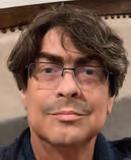
1988 35th reunion
A few more new words: deconstructivism, onboarding, unibrow.
1989
Monica Wesolowska has launched her debut children’s picture book! (See Reediana.)
1990
And a few more new words: cyberculture, microplastic, polyamorous.
1991
After about 11 years on the California coast, Matthew Twining has moved back to the humid Southeast. He’ll be teaching eighth-grade science at the Duke School in Durham, North Carolina.
1992
John Worsley writes, “When my wife, Amy Heil , died suddenly in January 2021, it occurred to me that we don’t, as people in our daily lives, talk much about the grief we go through. And I wanted to do something to change that. So I started posting on Facebook about what I was feeling and thinking and learning as I grieved. At first the posts were simple and short, but people responded in an encouraging and supportive way, telling
26 Reed Magazine december 2022
me that what I was sharing was meaningful to them. I kept going, and opened up more. And it slowly became clear that I was helping people. . . . Then a friend suggested that he could see a book like this being useful to counselors. I pondered that for several months, initially reluctant because it felt presumptuous to think I had enough to say to justify a book. But the weight of all the continuing feedback finally caught up to me, and I decided that if this content could help so many of the people I know on Facebook, maybe it could help people out in the world too.” A year later, John has published that book. (See Reediana.)
1993 30th reunion
Jessica (Stern) Benjamin shares that her senior year housemate Meisha Rosenberg has purchased a home five miles away in Wellesley, Massachusetts. Meisha lives there with her son and her dog, Chip. This development has led to the devouring of many fish kabobs; dog playdates; discussions about whether the duo’s three dogs are, in fact, Jewish; and the possibility that Jessica may someday exercise again.
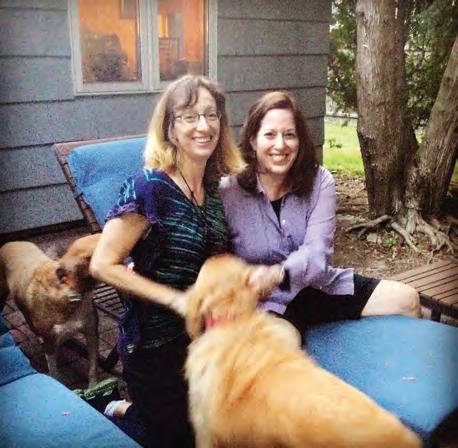
Vijay Shah recently edited Man on a Mission: James Meredith and the Battle of Ole Miss, a historical comic released in July 2022 by University of Arkansas Press.
(See Reediana.)
1994
How did it get so late so soon?
1995
Yoram Bauman is enjoying life in Salt Lake City, working hard to bring his economics comedy business back to life after the pandemic. He was fortunate enough to get a $50,000 ACX grant to advance pocketbook-friendly state-level climate action by 2024 in at least seven states (#climate24x7) and is pushing that rock up the hill with a Utah ballot measure effort called Clean the Darn Air (DarnAir.org) and with a Climate Action Tax

Cut idea for states like Arizona, Georgia, Nebraska, New York, Pennsylvania, and South Dakota. (C’mon, people, it only takes 17,000 signatures to get a measure on the ballot in South Dakota!) More at standupeconomist.com about all that, plus his new book: The Cartoon Introduction to Climate Change, Revised Edition (see Reediana).
Enabling Mathematics Learning of
Struggling Students, coedited by Helen Thouless, was published this summer.
(See Reediana.)
1996–97
It’s night before it’s afternoon.
1998 25th reunion
Hog Haven, a documentary by Christopher Beeson MALS, was shown nationwide this fall. (See Reediana.)
Jamie Isenstein’s exhibition Spectacle has been documented in catalogue form by Milan gallery Gluck50. (See Reediana.)
1999–2000
December is here before it’s June. My goodness how the time has flewn.
2001
Jenny Benevento contributed to a book, out now! She researched and indexed the book as well as writing a literature review about the history of diagrams. The book is Stuck?: Diagrams Help, by information architect Abby Covert. More info on how to buy a paper copy at https://abbycovert. com/stuck/. (See Reediana.)
Darlene Pasieczny visited Wall Street this summer.
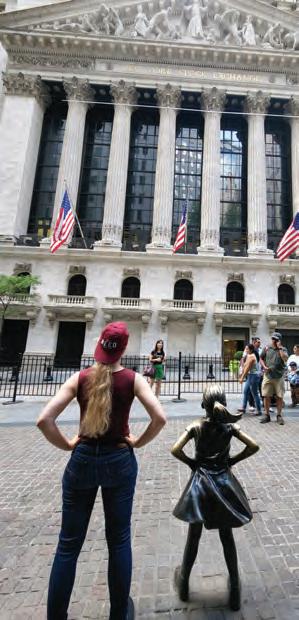
2002
How did it get so late so soon? —Dr.
2003 20th reunion
Seuss
Julia Haskin and Brian Searle ’01 have been delighted to have their lives turned upside down by the arrival of Rosalind Cora (future Reedie, class of ’44). In keeping with the Reedie ethos of lifelong learning, she has helped them learn to go without sleep; change diapers almost without looking; juggle a squirming baby, a bottle, and a cat who’s feeling neglected, all at once; and rediscover the marvels of the everyday through her eyes. Her current favorite activities include blowing raspberries, reading Goodnight Moon, and petting the trees and bushes outside.
2004
Megan Labrise was elected president of the National Book Critics Circle. Her current term ends in March 2023.
2005
Paul Marthers MALS is excited to announce the publication of Managing the Whole Student Life Cycle (See Reediana.)
2006
Edna Bonhomme finally completed her COVID-delayed wedding to her partner Harry Stopes, two years and a day after they legally tied the knot without any guests present. The festivities took place
Yoram Bauman ’95 at a Salt Lake Bees game with Zadie (7), Teddy (3), and Bumble (age unknown).
Jessica Benjamin ’93 and Meisha Rosenberg ’93 are neighbors!
27 Reed Magazine december 2022
Darlene Pasieczny ’01 (left) and Fearless Girl face down the New York Stock Exchange.
in late August 2022 in Berlin, where the two—both writers—have been living for several years. Andrew Ritchie ’07 was the MC, and alea adigweme, Joshua Rahtz, and Leah Johnston also joined the party. In keeping with the radical tradition which first drew Edna to Reed, she and Harry met at a Marxist reading group.
Kasey Jones was recently appointed as a managing director at Virtual, Inc.
2007
Aidan Sigman ’13 dropped in on Jess Thompson in Medford, Oregon, while hiking the PCT.

2008 15th reunion
How about some more new words? Bitcoin, mansplain, unfollow.
2009
In August, Jonathan Kominsky started his dream job: a tenure-track faculty position in the Department of Cognitive Science at Central European University in
Vienna, Austria. “I and my spouse, Fluffy Cass ’10, are excited about living and working in a city as beautiful, walkable, and vibrant as Vienna. Fluffy, who is now a senior science editor in the education wing of the Journal of Visualized Experiments, is particularly excited that she can meet with her India-based team of writers and editors at a more reasonable time than 7 a.m.” Sidney Rothstein published a book this year. (See Reediana.)
2010
Within a busy 24 hours, Sandra Bullock accepts—in person!—a Golden
Raspberry Award for Worst Actress and an Academy Award for Best Actress.
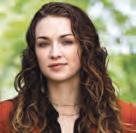
2011
Molly Radany has started a business in Southeast Portland! Experiment PDX is an arts & sciences workshop venue and events space—for Portland, by Portland. It’s got classes, lectures, performances, gallery, interactive exhibits, and nerdiness of all varieties—curiosity, creativity, and playfulness for all! “As a biology major, starting a business was definitely not what I thought I’d be doing in life after Reed, but I’ve realized it’s what
clockwise from top left Rosalind Cora brings the fun to Julia Haskin ’03 and Brian Searle ’01.
Leah Johnston ’06, Joshua Rahtz ’06, Edna Bonhomme ’06, Andrew Ritchie ’07, and alea adigweme ’06 celebrate Edna’s wedding to her partner Harry Stopes.

Aidan Sigman ’13 dropped in on Jess Thompson ’07 in Medford, Oregon, while hiking the PCT.
Kasey Jones ’06 has a new job!

Alex Houston ’13 and Ned Carson ’13 got married in the company of 16 fellow Reedies! Left to right: Jemana Theis ’13, Alison Chavez ’14, Crystel Hadley ’13, Karen Silbert ’13, Max Del Giudice ’14, William Purtzer ’13, Elizabeth Maxon ’13, Simone Wood ’13, Margaret Perry, James Bianconi ’13, groom Ned, bride Alex, Cole Perkinson ’13, Dani Parisi, Nick Pittman ’13, Kim Etingoff, Natalie Farnham ’14, Molly Isken ’14, Sam Hopkins ’13, Allie Cislo ’12, and Anna Cooper ’13.

“A s a biology major, starting a business was definitely not what I thought I’d be doing in life after Reed, but I’ve realized it’s what Reed most prepared me for: igniting curiosity.”
28 Reed Magazine december 2022
—Molly Radany ’11
Reed most prepared me for: igniting curiosity. An alum at Reunions said, ‘It sounds like Paideia, every day.’ That was the perfect description. So, in homage to my Reedie roots, I describe myself as an Entreprenerd.” See experimentpdx.com for info, events schedules, and how to share your personal passions with Portland!
2012
A few Reedie athletes saw each other at the World Ultimate Club Championships in Cincinnati, Ohio. Andrei Stephens ’08 cheered from the sidelines, Bryson Fox ’10 coached Seattle Mixtape to a gold medal in the final after playing (and winning gold) in 2018, and
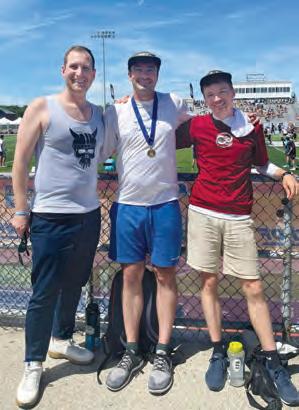
Francis Dieterle participated with his club team (25th out of 48 with Paris Université Club).
2013 10th reunion
On June 25, Alex Houston and Ned Carson were married in New Bedford, Massachusetts, on a peninsula overlooking Buzzards Bay. They were joined by 16 fellow Reed alumni along with family and friends.
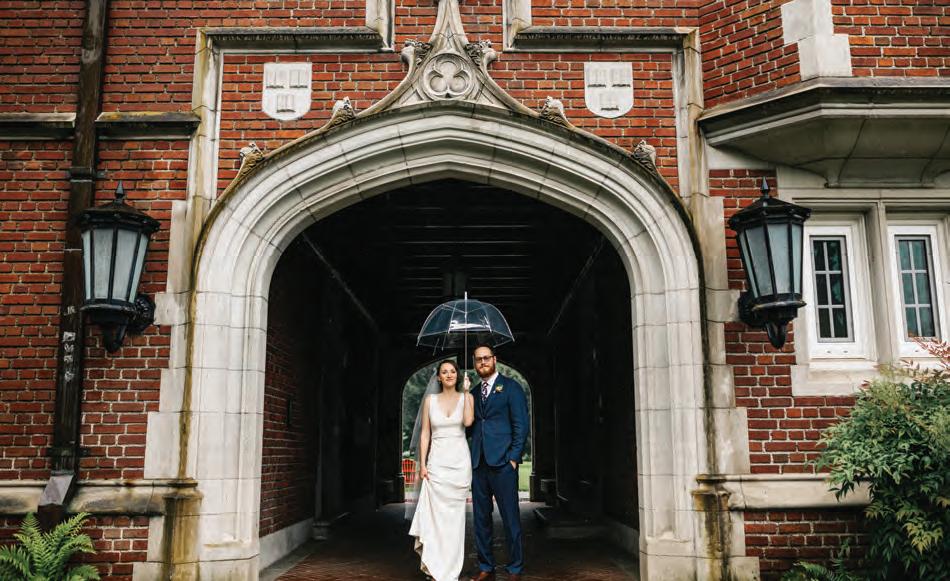
François Vigneault’s translation of Talli: Daughter of the Moon came out this fall. (See Reediana.)
2014
Dean Schmeltz and Allison Morgan, who met on Mac II in 2010, returned to
Reed for a belated wedding on June 17, 2022, to celebrate their 2019 marriage. A small group of family and friends (~50% Reedies) gathered for a nontraditional ceremony in Eliot Chapel—officiated by Annam Swanson—followed by a wonderful reception at Coopers Hall. It was the same as it ever was, yet once in a lifetime.
2015–17
Cold December night
2018 5th reunion
Moon and stars pave the sky in
2019–22
Pale pearl and diamonds —Author unknown
Drink & Draw— creativity time for grown-ups, Thursday nights at Experiment
At the World Ultimate Club
 clockwise from top left
Newlyweds Allison Morgan ’14 and Dean Schmeltz ’14 pose at the Sallyport.
PDX, Molly Radany ’11’s new business.
clockwise from top left
Newlyweds Allison Morgan ’14 and Dean Schmeltz ’14 pose at the Sallyport.
PDX, Molly Radany ’11’s new business.
29 Reed Magazine december 2022
Championships in Cincinnati, Ohio, left to right: Andrei Stephens ’08, Bryson Fox ’10 (with medal!), and Francis Dieterle ’12.
EDITED BY RANDALL BARTON Email bartonr@reed.edu
A Quest for Meaning
Barbara Ehrenreich ’63

September 1, 2022, in Alexandria, Virginia, from a stroke. As a general rule of life, Barbara felt, if a door opens, one should walk on through and at least take a look around. She approached life as a scientist, became a brilliant wordsmith, and enjoyed a successful career as a writer, focusing on ordinary people. Championing the overlooked and the forgotten, she tackled the myth of the American dream, the labor market, health care, poverty, and women’s rights.
She was born in the copper-rich town of Butte, Montana, where her father, Benjamin Alexander, worked as a miner. After earning a PhD in metallurgy at Carnegie Mellon University, he became a mining industry executive and moved his family, first to the East Coast, and then to Southern California. Barbara’s mother, Isabelle Oxley, was a discontented housewife. Both parents were heavy drinkers.
“My mother’s anger was the central force field in our home,’’ Barbara wrote in Living with a Wild God (2014). “She cleaned and scrubbed and seethed and cursed, to what I saw early on was an unusual degree, since my playmates judged her to be ‘mean.’ When in an outbreak of defiance I passed this information on to her, along with a personal declaration of hatred, she washed my mouth out with soap.”
A self-described fourth-generation atheist, Barbara began journaling in the ninth grade. At that time, she set her goal for life: to find out why—what is the point of our brief existence? She pondered whether it would take years of patient study to comprehend, or whether it might come in a rush of revelation. “You learn early in this line of work,” she wrote, “you can’t go around telling people, ‘I’m on a mission to discover the purpose of life.’”
Throughout her teenage years, she repeatedly experienced otherworldly encounters, which she found both unsettling and difficult to describe. One day, for example, she was looking at a tree and witnessed “something peeled off the visible world, taking with it all meaning, inference, association, labels, and words.”
“What do you do when confronted with an inexplicable and alarming situation?” she asked. “Well, you can panic or give in to some other tyrannical emotion, like dread. Or you can escape into a book or a puzzle or, judging from the adults around me, a bottle of gin. But there is another possible response to the unknown
and potentially menacing, and that is thinking.”
Years before she began journaling, when she was about eight years old, she had a rule: Think in complete sentences. Eventually the rule evolved into “think.” “No giving way to inner screams or sobs—just keep stringing out words in grammatical order.” Every now and then, she ceased trying to transform the hail of incoming images into named objects. But the thrust of her inquiry continued to be the meaning of life.
“We live our little lives, then we die,” she wrote, “but the payoff was supposed to be some glorious meaning, for anyone clever enough to find it, that would light up the sky, perhaps at the moment of death, like the aurora borealis, and redeem all the trivia and suffering. That’s what ‘meaning’ is—a special additive like salt or garlic that could make the most fetid piece of meat seem palatable, even delicious.”
Her parents couldn’t afford to send her to an East Coast college, which was Barbara’s hope when she graduated from high school in Los Angeles.
Feeling alienated in high school, she wanted to be free of its deadly conformity. The Beat generation was emerging in Los Angeles, and Barbara had an inkling that there was a bohemian culture at Reed in which she would thrive. In the fall of ’59, she started at Reed with what she termed “a few hundred other misfits” who were also whip-smart.
“Reed brought together the currents of a kind of youth rebellion in people like me who weren’t even ‘radical’ in any other sense with a feeling of an intense intellectual adventure,” she said. “I think those things have always gone together in my life, the idea that there is an adventure—this is an adventure—and that there are other people along the way to link up with sometimes and be inspired by and gain solidarity from.”
Arriving at Reed during what she called “the great surge of scientific reductionism,” she resolved to focus on the building-block disciplines: mathematics, chemistry, and physics. She began as a chemistry major and then went into physics.
In Memoriam
30 Reed Magazine december 2022
Jared Soares
“I had professors who really turned me on to the sciences,” she remembered. “I’ll always remember Prof. Jean Delord [physics 1950–88] standing in front of the class and saying, ‘Take the sun.’ And the poetry of that just struck me so much—that a human being could kind of ‘take’ the sun and consider it. I remember being so challenged and so engaged. The word ‘intense’ doesn’t begin to come close to what was going on.”
She wrote her thesis, “Electrochemical Oscillations of the Silicon Anode,” with Delord advising. But the thesis experiments that she set up with Delord, measuring semiconductor effects on the corrosion of silicon, yielded inexplicable voltage oscillations that seemed to be almost supernaturally mocking her efforts to account for them.
She went on to earn a PhD in cellular immunology from Rockefeller University, where she met her first husband, John Ehrenreich. As a graduate student, she discovered that the problem with science was that it involved working in windowless laboratories and she lacked the requisite patience for lab work. Toiling at the production end of science, all she could foresee was a lifetime of jobs with the chance to one day present some crumb of research results at a scientific meeting. The research gave way to antiwar activism, and Barbara decided against pursuing a career in science.
She became an assistant professor in the health sciences program at the State University of New York, Old Westbury, but, spurred by the social and political upheaval of the ’60s, she began to write. Her first book, Long March, Short Spring: The Student Uprising at Home and Abroad (1969), cowritten with her husband, grew out of their anti–Vietnam War activism. Their second book, The American Health Empire: Power, Profits and Politics, was published the following year.
At various times she taught, lectured, or served as writer in residence at UC Berkeley, the State University of New York at Old Westbury, the University of Missouri at Columbia, New York University, Sangamon State University, UC Santa Barbara, Ohio State University, and the University of Oregon.
In 1974, Barbara quit her teaching job to become a full-time writer. She became a regular columnist for Time magazine and The Progressive, and wrote for Ms. magazine, The New York Times, Mother Jones, Atlantic Monthly, The New Republic, and other publications. Numerous critically acclaimed books followed, including The Hearts of Men: American Dreams and the Flight from Commitment (1983), Fear of Falling: The Inner Life of the Middle Class (1989), The Worst Years of Our Lives: Irreverent Notes from a Decade of Greed (1990), and Blood Rites: Origins and History of the Passions of War (1997)
In 2001, she had a bestseller with Nickel and Dimed: On (Not) Getting By in America, a vivid account of her two-year immersion in the minimum-wage economy attempting to live on low-wage jobs. Selling more than a million copies,
the book became a turning point in her career. She began writing a guest column for the New York Times while a regular columnist was on leave and received so much acclaim for her columns that she was invited to stay on as a full-time columnist. But preferring to spend her time on long-term activities, like writing books, she declined.
“My real job, as I understood it,” she wrote, “was to be a sentry patrolling the perimeters of the human community, always on the lookout for fresh outbreaks of violence and danger, ready to sound the alarm. I became attached to the word ‘freelance’ for its martial connotations.”
The short pieces entertained and supported her; the longer, historical excursions fed her mind.
“At first I wrote books on relatively manageable issues related to class and gender in American society,” she wrote, “and then, realizing I had nothing to lose, turned to much larger issues— too large, in fact for any legitimate social scientist—like religion and war.”
After the release of Nickel and Dimed: On (Not) Getting By in America, she was diagnosed with cancer. She wrote about her breast cancer experience in an article titled “Welcome to Cancerland,” in which she described her experience and the problems with the breast cancer industry. Barbara survived the cancer and began revisiting questions she had laid out in her teenage journals. Her resulting memoir, Living with a Wild God, became a fascinating treatise on the mystical and unexpected, the possibility of a nonhuman agent or agents intervening in our lives.
In 2018, Barbara published her 20th book, Natural Causes, in which she wrote with skepticism about modern medicine with its aggressive promotion of dubiously valuable medical tests and pharmaceuticals. No more bone-density scans for her, she said, and no more painful and humiliating mammograms or colonoscopies. The book was something of a sequel to her 2009 polemic Bright-Sided, about the cult of “positive thinking” and how it demoralizes people who are already contending with crushing financial or medical issues.
Barbara was the commencement speaker at Reed in 1987 and contributed an essay to Thinking Reed: Centennial Essays by Graduates of Reed College. She was an honorary cochair of the Democratic Socialists of America and served on the board of the Institute for Policy Studies, the advisory board of NORML, and the editorial board of The Nation. She was the recipient of a Ford Foundation Award for Humanistic Perspectives on Contemporary Society, a Guggenheim Fellowship, a research and writing grant from the John D. and Catherine T. MacArthur Foundation, a Nation Institute/Puffin Foundation Prize for Creative Citizenship, the Hillman Prize for excellence in journalism, and a National Magazine Award for excellence in reporting.
Barbara had two children with John Ehrenreich, and, after divorcing him, married Gary Stevenson in 1983. They divorced in the early
’90s. In 2005 she wrote, “I dismissed the last of my male companions for a number of compelling reasons, topped by my need to be alone, which had become far more urgent than any romantic attraction.”
She is survived by her daughter, Rosa Brooks, a law professor, journalist, and author, and her son, Ben Ehrenreich, a freelance journalist and author.
Robert Stacey Jr. ’72
September 8, 2022, in Portland, Oregon, from the effects of meningioma.
For more than 50 years, Bob’s visionary commitment made Portland a national leader in sustainable growth. As an activist, advocate, planner, policy wonk, and public servant, he championed Oregon’s groundbreaking land use principles and served for nearly nine years on the Metro Council.
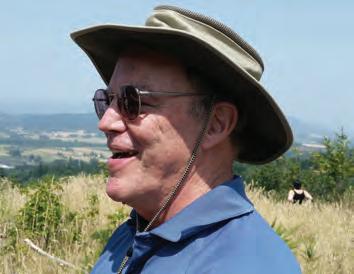
Bob grew up in Portland, but as the son of an army soldier, he spent long periods of time abroad, including most of high school in Frankfurt, Germany. After graduating from Parkrose High School, he started at Reed in the tumult of the late ’60s. He was a sophomore when the first Earth Day was held, and Bob remembered it as an initial pull toward environmental politics. He wrote his thesis, “Governmental Structure v. Environmental Planning: Bonneville Power’s Hydro-Thermal Program,” advised by Prof. Maure Goldschmidt [political science 1935–81]. Interested in public service, he went to law school at the University of Oregon to acquire skills in forming public policy. Bob interned with Henry Richmond, an attorney who founded 1000 Friends of Oregon. In an effort to keep the Willamette Valley from becoming an endless suburb from Portland to Eugene, Gov. Tom McCall launched the state’s land use planning program in the ’70s. He tasked Richmond with organizing an advocacy group called 1000 Friends of Oregon. When he graduated from law school, Bob was hired as a staff attorney for 1000 Friends, working on key pieces of litigation to get the right interpretations of statewide planning goals adopted. During his 11 years with the nonprofit, he rose to senior staff attorney. On behalf of 1000 Friends, he sued Metro to tighten restrictions on the region’s urban growth boundary.
He was at the forefront of 1000 Friends’ battles with the Rajneeshee cult’s attempts to take over Wasco County’s government and build
31 Reed Magazine december 2022
a city on designated farmland near the town of Antelope, Oregon. A box of chocolates arrived at the 1000 Friends offices in Portland with a note signed “From the Friends of the Columbia Gorge.” Bob sampled the chocolates and called to thank the director of Friends of the Gorge, who replied, “We didn’t send you any chocolates.” He then got a call from one of his allies in Wasco County, who said, “Bob, we got a box of chocolates from 1000 Friends.” Bob didn’t get sick. But it wasn’t until after conducting a bioterror attack on the salad bars in The Dalles that sickened 751 people that the Rajneeshees gave up on their dream of a commune near Antelope.
In 1987, Bob became the executive assistant for City Commissioner Earl Blumenauer, and two years later became the director of the Portland Bureau of Planning. He was less focused on the day-to-day needs of developers and builders than he was captivated by the bigger picture of regional growth. Believing residents were beginning to see growth less as an evil than “as a way to make a better future possible,” he wanted to make Portland the least automobile-dependent, most compact, and most livable metropolitan area in North America. After five years with the city, he was booted out by Commissioner Charlie Hales for not getting along well enough with developers. A week later, he was invited to join Gov. Barbara Roberts’s staff as an adviser on land-use issues, and then served twice as Rep. Earl Blumenauer’s chief of staff in Washington, D.C.
In 1995, he joined the Portland law firm of Ball, Janik and Novack as a partner specializing in land-use and development cases, and then became president of the board of directors of the Oregon Environmental Council.
Two years later, he became Tri-Met’s top policy wonk and executive director for policy and planning. It was another link between the regional government and the founding era of Oregon’s land use program. In 2002, Bob was drawn back to 1000 Friends as executive director.
Bob lost a narrow race for Metro Council president to Tom Hughes in 2010. Two years later, he was elected to Metro Council District 6 and pursued his passions for affordable housing, the efficient use of land, and the protection of farms and forests. He advocated investment in a robust bicycle, pedestrian, and transit network and served on the Metro Policy Advisory Committee, the region’s roundtable on transportation. Bob advocated increased housing density and prioritizing affordable housing near MAX stations. He won reelection in 2020, but stepped down for health reasons in 2021. The City of Portland recognized his contributions to sustainable growth in the Portland area when it named a bicycle/pedestrian bridge the Bob Stacey Crossing in his honor.
Stacey is survived by his wife, Adrienne, and daughters, Amanda and Hesper.
Enny Deutschman Schulz ’40
December 23, 2021, in St. George, Utah, at the age of 103. Enny was a Portland native who came to Reed as a “day-dodger.” She took part in weekend hikes facilitated by the college, including climbing Eliot Glacier on Mt. Hood, and particularly appreciated the humanities program. “To be sure,” she said, “the introduction of that program was too fast-paced, too overwhelming for a naïve freshman student. But since then, it has been a boon as a guide for stimulating reading material.”
She wrote her thesis, “Rousseau’s Contributions to Music,” advised by Prof. Cecilia Tenney [French and music 1921–63]. Enny’s objective was to be a teacher, and she ended up teaching high school in Oregon, first in Taft, and then in Gresham. She spent the last 17 years of her life in St. George, Utah.
At Reed, she met John Schulz ’39 , who would become her husband, and they had two sons, John O. and Gerald, who survive her.
Jeanne
Steed ’47
June 14, 2022, in Salem, Oregon.
Jeanne grew up on the south shore of Long Island in the small town of Westhampton. She was glad to have grown up in New York, because at the time she felt it was ahead of the rest of the country in providing opportunities for girls to be physically active. She participated in a sport or activity every season, including baseball, basketball, volleyball, archery, and dance. In addition, she swam, rowed, biked, and hiked. She attended a two-room grade school, graduated from Westhampton High, and then did postgraduate study at Northfield Seminary.
Her parents had been enchanted by the Northwest when they toured it on their honeymoon, and when it came time for Jeanne and her sister to choose colleges, they set their sights on Northwest schools. Jeanne chose Reed, where she majored in biology and took as many PE courses as possible, including badminton, team sports, and swimming, earning her lifeguard certificate swimming in the outdoor pool. She wrote her thesis, “A Study of Mitotic Rate Fluctuations in Tadpole Tails,” advised by Prof. Ralph Macy [biology 1942–55].
“Reed changed the way I thought about the world,” she said. “I realized mental structures were necessary to go along with the thinking.”
Jeanne met her future husband, George Raymond (Ray) Steed ’41 , while accompanying Prof. Frederick Ayres [chemistry 1940–70] on a hiking trip to Eliot Glacier on Mt. Hood. Jeanne and Ray married in the Reed chapel, where she was given away by Prof. Arthur Scott [chemistry 1923–79]. A year later, the couple headed off to the University of Oregon, where each earned a master’s in education. Ray eventually served an eight-year term on the Reed Board of Trustees and was president of the Reed College Alumni Association.
Jeanne taught biology and algebra for a year at Girls Polytechnic High School in Portland, and then focused on her family and home building. She began substitute teaching in 1962 and finished the year teaching math at Wilson High School. She moved to Jackson High School, where she started the computer math program.
For Jeanne, mental challenges were as important as physical activity. She played bridge every week and was a member of the League of Women Voters for 50 years, also serving as its president. After retiring from teaching in 1983, Jeanne began doing synchronized swimming. She was a multiple masters national champion and was awarded the Mae McEwan Award given by U.S. Synchronized Swimming for her contributions to the sport. She served on Reed’s alumni board, participated in alumni college and the alumni travel program, and received the Alumni Programs Volunteer Award.
She is survived by her daughter, Laurie Cook, and her son, Mike Steed.
Herb grew up in Portland, graduated from Richmond Elementary and Franklin High School, and joined the U.S. Navy prior to the end of World War II. After the war, he came to Reed, earned a degree in mathematics, and then enjoyed a career as an industrial developer in Oregon and Washington. He also worked for the Spokane, Portland and Seattle Railway, which eventually merged with other regional railroads to form the Burlington Northern Railroad.
He married Barbara Osborn, and in 1992 they moved to Brightwood, Oregon. Herb was an avid weather watcher and frequently reported weather statistics from the Brightwood-Welches area to Portland news station meteorologists. He also wrote the weather column for the Welches Mountain Times newspaper for many years.
Herb was a long-term volunteer driver for the local Meals on Wheels program in Welches, and was a Master Gardener. In 2018, he and Barbara moved back to the Portland area. She survives him, as do his sons, George, Marty, and Glen, and his daughter, Judy Johansen.
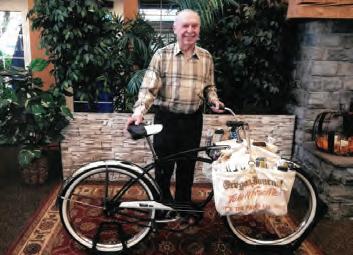
In Memoriam
Herbert W. Miller ’50 June 8, 2022, in Portland.
32 Reed Magazine december 2022
Sydney Shoemaker ’53
September 3, 2022, in Ithaca, New York, following a brief illness.
Professor emeritus of philosophy, Sydney was a leading figure in the College of Arts and Sciences at Cornell.

Remembered as a powerful thinker and brilliant teacher, he contributed to the outstanding reputation of Cornell philosophy during the latter half of the 20th century.
Sydney was born in Boise, Idaho. At Reed, he wrote his thesis, “The Critical CommonSensism of Charles Sanders Peirce,” advised by Prof. Edwin Garlan [philosophy 1946–73]. He attended the University of Edinburgh as a Fulbright scholar and then earned his PhD at Cornell. After teaching briefly at Ohio State University, he returned to Cornell in 1961, becoming a full professor of philosophy at the university in 1970. During that time, he trained many well-known philosophers.
Fusing disparate points of view, Sydney became one of the great Cornell philosophers of the 20th century, said Derk Pereboom, Cornell professor of philosophy and ethics and senior associate dean for arts and humanities.
“He earned his doctorate at Cornell in 1958 under the supervision of Norman Malcolm, at the time the leading advocate in the United States of the philosophy of Ludwig Wittgenstein,” Pereboom said, “Shoemaker’s work, especially early in his career, was marked by this influence.”
Characterized by a lack of vanity and diffident self-presentation, Sydney had a commanding way of sharing ideas. He was a leading figure in the fields of metaphysics and philosophy of mind, and published many papers in these areas. Beginning in the late ’60s, Cornell became a center for scientific realism, a contrasting point of view. “In subsequent decades,” Pereboom said, “Shoemaker’s research was fueled by a productive tension between these two philosophical perspectives.”
“He was the reason I wanted to go to Cornell for graduate study and he was the most wonderful adviser I could have imagined,” Richard Moran, professor of philosophy at Harvard University, wrote. “He was the opposite of an adviser who insists that you conform to their particular way of seeing the problems. With him, I always felt that precious combination of freedom, guidance, and encouragement that anyone needs to flourish in graduate school.”
He received a George Santayana Fellowship at Harvard University, a John Locke Lectureship at Oxford University, a Josiah Royce Lectureship at Brown University, a National Endowment for the Humanities Fellowship, and a Guggenheim Fellowship. He was elected to the American Academy of Arts and Sciences in 1996.
Sydney was the author of Self-Knowledge and Self-Identity (1963) and Identity, Cause and Mind: Philosophical Essays (1984). With Carl Ginet, he coedited Knowledge and Mind (1983) and cowrote Personal Identity (1984) with Richard Swinburne. He served on the editorial boards of the Philosophical Forum, Philosophy Research Archives and Philosophical Studies and was a coeditor of the Philosophical Review and general editor of Cambridge Studies in Philosophy. He was a former chair of Cornell’s philosophy department and president of the Eastern Division of the American Philosophical Association. Sydney is survived by his wife, Molly, and his son, Peter.
Alan Duane Ullberg ’54
July 7, 2022, in Flossmoor, Illinois. Alan wrote his thesis, “The Board of County Commissioners of Multnomah County, Oregon,” advised by Prof. Charles McKinley [political science 1918–60]. He went on to get a degree from Harvard Law School and then clerked for two justices of the California Supreme Court. He worked as a special counsel to James Webb, was an administrator of NASA in Washington, D.C., and served as associate general counsel of the Smithsonian Institution from 1970 to his retirement in 1998. Alan is survived by his wife, Patricia, and his son, Rohin.
Christopher West Colie ’56
November 13, 2021, in Portland, Oregon.
HONOR
In remembering Chris, one might begin with the scope of his knowledge: the literature, philosophy, and poetry he read and dissected in latenight conversations with companions on his large wraparound porch. He had a deep curiosity that turned to everything from boxing techniques to the nature of truth and human behavior. Chris could tell you how to read the tides, befriend a worried dog, throw a knife, or roll safely when hopping off a freight train.
He was a gifted storyteller and humorist who took care to lay the groundwork for stories that

THE SPIRIT OF REED

giving.reed.edu
gift
Reed
name. You can
Reed
for the next generation.
Honor your professors and classmates with a
to
in their
make
possible
THEIR Memory IN
often led to being the butt of the joke, such as the time he was hoodwinked by a chimpanzee at the zoo. But his tales could also skewer the strutting idiocy of an army officer he ran into in Panama or a power-drunk boss on the waterfront, and they were laced with colorful descriptions. An out-of-place person might be described as looking “like a Bengal tiger roaming through a palace hall.”
The youngest of four children born in Spring Lake, New Jersey, he spent most of his childhood in his family’s home at the shore in Mantoloking, which led to his lifelong obsession with the ocean and the beach. As a student at Reed, he met his future wife, Carole Calkins Colie ’54 He was the edgy, brilliant East Coast kid who made his way to Reed after running away from boarding school and shipping out on freighters headed to the Caribbean. She was the sparkling, talented redhead whose party Chris attended and (without realizing she was hosting the party) convinced to ditch. Carole was friends with Chris’s roommate, Frank Crawford ’54, who told her Chris was weird, even by Reed standards.
One day Carole, who shared a creative writing class with Chris, read aloud a story about a November 1919 Armistice Day parade in her hometown of Centralia, Washington. The Legionnaires had charged the International Workers of the World union hall, and four of them were shot by one or more men inside. One IWW member, Wesley Everest, was lynched, and while the killers of the Legionnaires were tried and punished, Everest’s killers were not. After class, Chris approached her and asked a lot of questions regarding public opinion in Centralia. He was terrifically interested in the subject and asked how to get to Centralia by train.
Chris’s roommate Frank would sometimes report why Chris was not in class on a particular day. “Colie won’t be coming to class today, Mrs. Collier,” he’d say. “He hopped a freight train to Seattle to see an old girlfriend.” Or, “He spent the night in a flophouse on Skid Row last night so he won’t forget what it’s like.”
The night Chris convinced Carole to ditch her own party, they ended up at Hung Far Low in Chinatown. They talked for three hours and Chris asked her to marry him. They took their final exams and drove to Lewiston, Idaho, to get married because they were both under the age of 20 and Idaho allowed “under age” marriage. When they returned from their honeymoon in Tijuana, a draft notice was waiting for Chris. He reported to Fort Dix for his basic training, but hated the army and less than a year later went AWOL. He eventually returned to base and was put under armed guard in the barracks. The plan was to send him to Korea, but the paperwork got mixed up and he ended up being sent to leadership school instead. He was then sent to Panama, which he enjoyed immensely, and was discharged
in 1954. In 1999, he published a book of letters he’d written to Carole, Naked to Love: Letters from a Young American in Panama 1952–54
When Chris returned home from the service, Carole asked him what he was going to do with the rest of his life. He didn’t know. She insisted he reapply to Reed. Chris liked his classes and studied hard, but by this time they had two children and he had to study at night after they went to bed.
After two years back at Reed, Chris decided not to return. He reasoned that six weeks was not enough time to spend on Hegel and got a job on the waterfront. If you didn’t like the boss you had one day, you could quit, go to the hall the next day, and toss in your plug for another job. It provided leisure with exercise, and Chris couldn’t have had more satisfying work. When containers took over the lifting, carrying, and storing that he enjoyed so much, he retired.
Chris had an affinity for the down-and-out. He always carried cash in case he encountered someone who needed a little help. He was strong and brave, but also very gentle. One time he told three of his daughters who wouldn’t go to sleep that he’d give them spankings if they didn’t settle down. Since he’d never raised a hand against them, they ignored his order and continued to jump around in their shared bedroom. Suddenly their door flew open and in walked their dad. In his hand was a long, inflated balloon with which he paddled each giggling girl before saying goodnight one more time.
He was always interested in exercise and sport. Chris described running for exercise on the streets of Portland in the 1950s. People stopped to stare at him like he was a madman. He kept meticulous notes tracking his progress weight lifting and the time he spent punching the speed bag in his garage. He was fascinated by boxing and loved tennis. In the fall, he watched college football games and raked the leaves at half-time.
Chris is survived by his son, Christopher (Kit); five daughters, Melissa, Tanya, Elizabeth, Amanda, and Nora; and an honorary daughter, Meiling.
Morris Bol ’58
June 28, 2022, in San Francisco, California.
Morris was born in Eindhoven, Netherlands, to Cornelis Bol, a physicist and inventor, and Josina den Haan, a chemist. In 1936, the family immigrated to Palo Alto, California. Morris was the fifth of six sons, all of whom predeceased him. He graduated from Palo Alto High School and then came to Reed, where he wrote his thesis, “A Study of the Negative Corona Gas Discharge Beads in Air,” advised by Prof. Jean Delord [physics 1950–88]. He received both a PhD in physics and an MD from Stanford University, where he was a Woodrow Wilson fellow.
Morris practiced medicine in Denver, Colorado, for 17 years. He was married and raised four children before he and his wife divorced. He met Lewis Crickard, who was involved with the theater program at the University of Denver. After Lewis joined the faculty at Dartmouth, the partners moved to Norwich, Vermont, where they lived for two decades. During that time, Morris practiced medicine at White River Junction Medical Practice and was an adjunct faculty member at Dartmouth Medical School, where he was a valued mentor to medical students who rotated through his clinic. For many years, students voted Morris “Best Teacher,” an unusual honor for a doctor who worked in the community.
He and Lewis moved to San Francisco and, after 34 years together, married at San Francisco City Hall in 2015. Morris is survived by his husband of 42 years, Lewis Crickard, and four daughters, Jennifer Bol, Dana Bol, Pamela Riess, and Rebecca Dupont.

Maryanna
Pearson Henkart ’58
July 2022, In Alexandria, Virginia.
When she was growing up in East Portland, Maryanna wanted to be an actress. But the Rev. O. W. Pearson, her father, convinced her she should be a scientist. She started at Reed as a biology major, living at home until her senior year, when she moved into Anna Mann. Maryanna performed in musicals at Reed and played the wife in the stage production of Death of a Salesman. She wrote her thesis, “Some Preliminary Studies on the Purification of a Tartrate Dehydrating Enzyme in Pea Seeds,” advised by Prof. Helen Stafford [biology 1954–87]. While at Reed, she met and married Arthur Warmoth ’59. They later divorced.
Maryanna earned a PhD in biology from Harvard University and had a two-year fellowship at Scripps Institute of Oceanography. She took a job as a senior investigator at the National Institutes of Health and then joined the National Science Foundation in Arlington, Virginia, where she became the director of the division of molecular and cellular biosciences. She married Pierre Henkart in 1967; they were divorced in 1988.
Katharine
Jaeger Steig ’58
August 12, 2022, in West Vancouver, British Columbia, from complications of a stroke.
Katharine met her husband Mike Steig ’58 at Reed. She finished her degree in education at the University of Washington. In 1966, she and Mike moved to West Vancouver, British Columbia, where she worked in the library and became actively involved in protecting the parks and wilderness on the edge of urban and suburban Vancouver. Katharine’s greatest passions were wild plants and the nature that supports wild creatures and
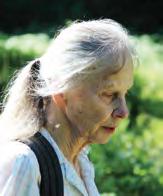
In Memoriam
34 Reed Magazine december 2022
nourishes humans. Her legacy can be seen from Vancouver to the North Shore Mountains, where an important stand of old growth forest still exists because of her efforts, and where two peaks in Cypress Provincial Park were saved from future development. She is survived by her two sons, Joseph and Eric; and her sister Winifred Wood ’55
David E. Fahrney ’59
April 14, 2022, in Fort Collins, Colorado.
David was born in Nebraska where, in his youth, he had many medical issues that kept him for long periods of time at the Fitzsimons Army Hospital in Colorado. He had lung issues and was one of the first civilians to receive penicillin, which saved his life.
He earned a bachelor’s degree in chemistry at Reed, where he wrote his thesis advised by Prof. Arthur Livermore [chemistry 1948–65] and then served two years in the army. He went on to study biochemistry at Columbia University, where he earned his PhD.
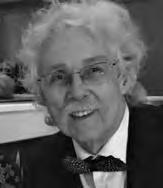
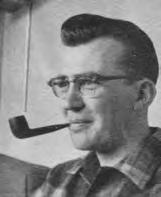
Dave developed a widely used inhibitor of esterases, PMSF, also known as Fahrney’s reagent. He was hired as an assistant professor at the department of chemistry at UCLA, where he continued research on enzyme mechanisms.
He married his wife, Eileen, in the late ’60s and in 1970 they moved to Fort Collins, where Dave was hired as an associate professor in the Colorado State University biochemistry department. He continued research on enzyme mechanisms, but also expanded work into metabolism of mycoplasma and thermophilic archaea, organisms that can live at extreme temperatures. During his last 20 years at CSU, Dave devoted most of his time to teaching. He taught most of the first-year graduate courses in both structural biochemistry and metabolism, excelling as an instructor in each area. A gifted teacher who inspired several generations of students, Dave had a great influence on many of his contemporary faculty members, helping them develop effective teaching styles and showing them how to engage students in course material. Among his most lasting contributions to instruction in biochemistry was his development of Interactive tutorials, for visualization of biochemical structures in a pseudo-3D mode, which became widely available. The tutorials have been downloaded freely more than 20,000 times from locations around the world.
Outside of university life, he was passionate about excelling in any activity, becoming a competitive skier after moving to Colorado. He won the top award for competition in his group, and as a marksman won several rifle marksmanship trophies. His wife was a photographer, and Dave took up this hobby. When she died in 2013, he continued to take photographs,
traveling the world on photographic tours with a group of professional photographers who critiqued each other’s work
Leslie McCune Grace ’59
May 1, 2022, in Seattle, Washington.
For her first nine years, Leslie lived on her parents’ boat moored at the Seattle Yacht Club. Subsequently the family moved to a house in the Montlake neighborhood, where Leslie attended Montlake School, Meany Middle School, and Garfield High School. She came to Reed for two years and completed her BA at Seattle Pacific University.
She taught social studies at Issaquah Junior High School for three years and dreamed of traveling the world. An idea took root when a friend idly commented to her, “Wouldn’t it be interesting to open an import shop?”
Leslie discussed the idea with her father, who loved it, and with the support of her family, in 1962 she opened what became the renowned La Tienda Folk Art Gallery in Seattle’s University District. Filled with handmade textiles, arts, and crafts from all over the world, the shop became a center for the appreciation of folk art. Through the gallery, as well as the many trips she guided to Mexico, Leslie promoted what she called “the beauty of the hand.”
Her life partner, Fred Hart, observed that Leslie “had a passion for the interaction of people’s hands with the physical objects of their lives that produced things of beauty and interest and meaning.”
She received the Mayor’s Small Business Person of the Year Award in 1989. In 1995, she sold the store to three employees, who kept the store open for another 18 years. After selling the business, Leslie continued to travel, consult, teach, and collect textiles. She was active in the Rotary Club of the University District, the Washington Commission for the Humanities, Seattle Weavers’ Guild, Seattle Textile and Rug Society, and Pangea Giving. She donated many pieces from her vast textile collection to the Burke Museum, and recently, more than 900 textiles were donated to the Mingei International Museum in San Diego. It was Leslie’s greatest wish that her life work be preserved, documented, and shared with a global audience.
She is survived by her life partner, Fred Hart, and her brother, Cal McCune.
Lee S. Isgur ’60
August 3, 2022, in Mountain View, California, from complications of COVID-19.
Born in Boston, Lee was a Red Sox fanatic throughout his life—as well as an avid skier, sailor, gourmet, and world traveler. After graduating from Belmont High School, he came to
Reed, where he wrote his thesis, “An Economic Analysis of Mutual Fund Stock Market Operations,” with Prof. Subbeah Kannappa [economics 1959–60] advising. At Reed he met Barbara Sloate ’63, whom he later married. They would go on to become one of Wall Street’s most influential couples.
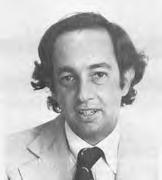
After getting an MBA from Dartmouth’s Tuck School of Business, Lee enjoyed a long career in finance. He worked as a financial analyst at Gruntal & Co., Paine Webber, and UBS, and was a pioneer in the analysis of firms in the leisure and entertainment industries. Lee was a frequent guest on the television show Wall Street Week. He won numerous awards within his industry, where he was widely considered to be one of the foremost analysts in the country. He was a managing partner of Corporate Counselors, a research and investment banking consulting firm, and was a principal and chief financial officer of Marche, a Menlo Park, California, restaurant that he helped found and organize. In later years, he worked as an investment banker at Volpe, Welty & Co. and Jefferies & Co., and served on the boards of various companies, including Station Casinos.
Lee is survived by one son, Michael, and was predeceased by Barbara, his wife of 49 years.
Michael Templeton ’63
April 26, 2022, in Portland.
Michael was a physicist and mathematician who made his life’s work the public understanding of science.
He was born in Wallace, Idaho, and started at Reed, but completed his bachelor’s degree and a master’s in mathematics at Portland State University. From the time he was a child, Michael took things apart to figure out how they worked. He began his career as an inventor at Tektronix and then became the director of science at the Pacific Science Center in Seattle. He held leadership positions at the National Science Foundation, the Association of Science and Technology Centers, and the Oregon Museum of Science and Industry. Michael supervised the science content on the groundbreaking children’s television show The Magic School Bus, encouraging millions of children to think of themselves as scientists and embrace their innate curiosity. He inspired the character of Dr. Marbles in the long-running WNET-13 children’s math show, Cyberchase , which he worked on for many years, reviewing scripts, designs, and animated stories to get the science right.
The Confederated Tribes of the Warm Springs had a special place in his heart. He served as the first interim director of the Museum at Warm Springs and was a roadie
35 Reed Magazine december 2022
In Memoriam
for the N’chi Wanapum Canoe Family, where Native American youth of the Warm Springs Indian Reservation connect with, interact with, and bond with elders. Up until the final week of his life, he read every book he could get his hands on.
Michael is survived by his wife, Linda Clingan; and his children, Darell Duffy, Martin Duffy, and Amelia Templeton.
Press, which focused on books for children and those who cared for them.
She inherited a love of the outdoors, which she passed on to her children and grandchildren. The Olympic Peninsula was the family playground, though later in life Carolyn gravitated towards Mt. Baker and Chuckanut Drive, Washington’s original scenic byway. Oysters were frequently featured on the menu, and Classical King FM was always on the radio. She was a member of the Shoreline Unitarian Church, where she served on the board and managed the construction of new church buildings. As with everything else in life, she managed those missions with kind words and high expectations.

Carolyn is survived by her children, Amanda Threadgill and Brendan Threadgill, and her two sisters, Julia and Priscilla.
Elana Dykewomon (Nachman) ’71
August 7, 2022, in Oakland, California, of esophageal cancer.
Carolyn was born in Wichita Falls, Texas, and grew up in Albuquerque, New Mexico, where her pet dog, Satan, made sure the kids stayed out of the arroyo during flash floods and kept the feral goats at bay. Carolyn spent two years of high school in Mexico City and then came to Reed, where she majored in classical studies. Advised by Prof. Frederic Peachy [classics 1956–82], she wrote her thesis, “The Rudens of Plautus: An Analysis,” entirely in Latin with the exception of the acknowledgments section, which was written in ancient Greek. She credited Reed with instilling in her the courage and analytical skills to tackle anything.
“I decided if I could do Reed, I could do anything,” Carolyn said. “Indeed, nothing since has been as difficult to succeed in. I learned the lessons I would need well.”
Carolyn was a book lover by nature and a book publisher by profession.
After completing a master’s degree in history at the University of Kansas, she moved her young family to Seattle, where she worked at Globe Pequot Press and then became executive director of Pacific Search Press, where she brought her background in the classics to a company whose shelves creaked with cookbooks and books on the outdoors, animals, travel, and recreation. Her aim was to produce books that were a cross “between the purely academic and the totally watered-down.”
She worked to make the Northwest a good area for publishing and was president of the Pacific Northwest Publishers Association. “What happens too often,” she said, “is that authors go east as soon as they can. I’d like to see that changed. I’d like to see our good authors stick around.”
Carolyn became the publisher at Parenting
Beginning with the publication of her first novel, Riverfinger Women, Elana became a central figure in lesbian literature, history, and activism.
She was born into a fiercely Zionist household in Manhattan, the eldest of Harvey and Rachel Nachman’s three children. Harvey had been a navigator in the U.S. Army Air Forces during the Second World War and then volunteered as a pilot in the Arab-Israeli War of 1948, while Rachel helped smuggle arms to Israel. Around the time Elena was eight, Harvey moved his family to Puerto Rico in 1958 to open a law practice.
As a child, Elana knew she was “different,” but doctors told her she couldn’t possibly be homosexual. When her family moved to Puerto Rico, she found the Latin macho culture alienating, with its sexual role playing by men and women. She attempted suicide when she was 11, and spent a year recuperating at Johns Hopkins Hospital in Baltimore. At Windsor Mountain School, a progressive boarding school in Lenox, Massachusetts, she came out as a lesbian and found a modicum of peace and acceptance.
Elana studied fine art at Reed for two years. She received a bachelor’s degree in creative writing from the California Institute of the Arts and a master of fine arts degree from San Francisco State University, where she later taught composition and creative writing for nearly two decades.
When she was 24-years-old, she published her debut novel, Riverfinger Women (1974), a ribald coming-of-age story about lesbian life during the social upheaval of that era. Initially written for— but rejected by—a straight publishing house
marketing a line of pornography for bored housewives, Riverfinger was the first to be advertised as a lesbian book in the New York Times
After the novel was published, Elana dropped the name Nachman, taking on the pen name Elana Dykewoman (later Dykewomon). “I chose ‘dyke’ for the power and ‘womon’ for the alliance,” she wrote in an essay published in a 2017 anthology, Dispatches From Lesbian America. “I figured if I called myself Dykewomon, I would never get reviewed in the New York Times. Which has been true. If I had it to do all over again, I might have chosen Dykestein or Dykeberg.”
Thus began a five-decade career as an outspoken writer of fiction, drama, and poetry. In the early ’80s, she settled in Oakland, California, drawn to the area because of its Jewish lesbian activist community, and was an organizer of the San Francisco Dyke March.
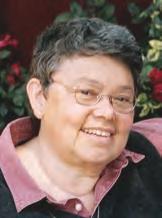
Her novel Beyond the Pale (1997) won the Lambda Literary Award for lesbian fiction and remains a classic in a genre that Elana pioneered. Tracing the entwined stories of Jewish lesbians from Kishinev, Moldova, to the Lower East Side, the story included Russian pogroms and the Triangle Shirtwaist Factory fire, one of the deadliest industrial disasters in U.S. history.
“It can’t be that we are the first generation of Jewish lesbian activists on the planet,” she said, “so part of what the novel is about is searching for our ancestors and ancestral community as Jewish lesbians.”
Though she was not religious as an adult, as a writer she maintained a strong sense of Jewish identity, frequently writing pieces on Jewish themes. She also edited Sinister Wisdom, a quarterly lesbian literary and art journal, and co-edited special issues including “To Be a Jewish Dyke in the 21st Century,” and another story told from the point of view of a woman wandering in the desert with the Israelites after leaving Egypt.
Elana also published five collections of poetry and short stories and contributed to many lesbian-themed publications. In May, she was officially named a “trailblazer” by the Golden Crown Literary Society for prose that depicted “the lives of women and lesbians, both contemporary and historical, allowing us to see our stories on the page long before those stories were widely available.”
Elana and her wife and longtime partner, attorney Susan Levinkind, lived in an East Oakland enclave that is home to other LGBTQ artists and writers. Elana could often be seen walking her little dog, Alice B. Toklas. Following the death of Levinkind in 2016 from Lewy body dementia, Elana wrote a play, How to Let Your Lover Die, a rumination on love and loss. It was one of only five works selected from the 240 submitted for this year’s Bay Area Playwrights Festival. This summer, Elana worked with the actors who would perform two livestreamed, staged readings of the play. She was in hospice at home with friends and died just 20 minutes
Carolyn J. Threadgill ’67 July 25, 2022, in Seattle, Washington.
36 Reed Magazine december 2022
before the start of the second staged reading. The friends, neighbors, and family members watched her play on Zoom before calling the authorities. When mortuary workers came for her body, those assembled filed out silently behind them and broke into spontaneous applause as her body was placed in the van. Elana is survived by her brothers, Daniel Nachman and David Nachman.
MALS ’72
Mike grew up in Seattle’s Beacon Hill neighborhood and attended Franklin High School. He joined the U. S. Coast Guard Reserve, and where he served as a medical corpsman and played the clarinet and saxophone in the U.S. Coast Guard band. He paid his way through college at Seattle University by working as an orderly at Harborview Medical Center and playing music professionally. He attended commercial art school in Seattle and for several years worked at Boeing doing commercial art and graphic design. He completed a master’s in teaching at Reed and a master’s degree from the University of Washington, where he met his wife, Tecla Jung. Married in 1970, the couple raised their family in the Wedgwood neighborhood of North Seattle.
At the age of 19, Mike converted to Catholicism and, in the mid-’60s, he attended a retreat at Mt. Angel Abbey in Oregon where he met Father Bernard Sander, a Benedictine monk who became his lifelong mentor. Mike served as an oblate of St. Benedict for many years. He and Tecla were also active with their local parish, Our Lady of the Lake.
Mike worked for the Shoreline school district for 30 years, where he taught high school special education and alternative education. After he retired, he and Tecla moved to Kingston, Washington. Mike enjoyed woodworking, carpentry, painting and drawing, winemaking, and music. He played the saxophone as a member of the Hometown Band in Kitsap County.
After lovingly planning Tecla’s 70th birthday party several years ago, Mike’s struggle with dementia became evident. He gradually lost the ability to speak, and his many interests and skills faded away. However, he continued to enjoy spending time with friends and loved ones, communicating with his bright blue eyes and brilliant smile, which he shared more freely than ever.
Mike is survived by Tecla, his wife of 52 years; and their children, Andrea Legge Chymiy, Elise Legge Dowling, John Legge, and Juliana Legge.
Dean Leland Alvis ’75
August 4, 2022, in South Bend, Indiana.
Born and raised in Portland, Dean wrote his thesis, “Closed Categories of Continuous Mappings,” advised by Prof. Thomas Wieting [math 1965–2016]. He went on to earn master’s and doctorate degrees in mathematics from the University of Oregon. Dean held faculty positions at MIT and the University of Notre Dame before joining the mathematics faculty at Indiana University South Bend where, until his retirement in 2015, he taught a wide variety of math courses and conducted research on representation theory.
Dean enjoyed hiking, and in his youth climbed some of the Cascade peaks of the Pacific Northwest. After moving to South Bend, he made many trips west with his family to camp and hike. A lifelong environmentalist, in his retirement he became more active politically. He joined Indivisible, where he met other local activists involved in progressive causes. He participated in Solarize South Bend, loved solving puzzles and problems, was a fan of mysteries and an avid film buff.
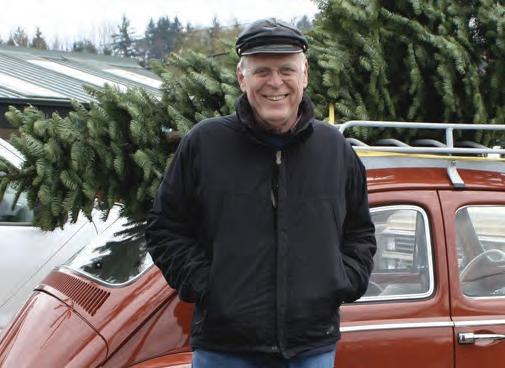
Dean is survived by his wife, Anne Brown, and his daughter, Claire Alvis.
Andrea L. Prentice ’77
June 18, 2021 in Yakima, Washington.
Born in Yakima, Washington, Andrea graduated from Davis High School before heading to Reed. She later transferred to the University of Washington, where she earned a bachelor’s degree in music and ethnomusicology, with an emphasis on piano. She lived in Seattle for several years and then in 1987 became co-owner and manager of Prentice Packing and Storage Company. The decision to return to Yakima and enter the family business proved significant in her life, reconnecting Andi to the Yakima Valley. She appreciated and valued the many people she worked with during her years at Prentice Packing.
Andrea’s passion was experiencing the world via hiking and cycling. She began her travels with a solo trip to India, Thailand, and Burma, and ended walking a final stretch of the Camino de Santiago and other pilgrim trails with her beloved partner, Charles Chesney, shortly before her cancer diagnosis.
Andrea was passionate about music and continued to develop her considerable piano skills throughout her life. She made 14 annual trips to the Sonata piano camp in Bennington, Vermont, and the confidence she gained there enabled her to share her musical gifts with the
Yakima community. Community engagement and support were important to her, and she gave her support to local arts and community organizations, including The Seasons Performance Hall, the Yakima Symphony Orchestra, and Yakima Music en Acción.
She is survived by her loving partner, Charles Chesney; her sister, Carol Prentice; and brother, David Prentice.
Eric J. Hanson ’78
August 20, 2022, in Salt Lake City, Utah.
Eric was raised in Southern California alongside his spirited twin brother, Mark. During his time at Reed, he spent a year studying at the Sorbonne University in Paris, where he absorbed the language and culture of France. He wrote his thesis, “Detection of Destructive Symbiosis and Role Reversal in the Abusing Family,” advised by Prof. Carol Creedon [psychology 1957–91]. Eric received a PhD in educational psychology from the University of Utah. After graduation, he met and married his wife, Sue, with whom he shared a life for 34 years. Their son, Ian, was born in 1991.
As a psychologist, Eric worked with adults, adolescents, children, and families at Valley Mental Health. He later transitioned his years of experience and insight into a meaningful private practice. He was also a masterful composer and pianist, and his music provided him with a depth of expression and beauty.
The ultimate challenge and perhaps his bravest endeavor in his life’s journey was when he was diagnosed with Parkinson’s disease in 2005. He endured with acceptance and grace. Eric is survived by his wife, Sue; his son, Ian; his brother, Mark; and his stepmother, Betty.
Alison G. Weisner ’81
June 10, 2022, In Menlo Park, California, from cancer. Alison lived nearly her entire life in the Barron Park neighborhood of Palo Alto, California. After graduating from Henry M. Gunn High School, she came to Reed, where she majored in economics and wrote her thesis, “The Present Value of Space Settlement Construction,” advised by Prof. Edward Schroeder [1979–80].
“I majored in economics because the subject seemed quirky and paradoxical (goodness knows, it is),” she said. “But when I had to apply it seriously I discovered I didn’t care to.”
Alison had a long career as a document librarian at Wilson Sonsini Goodrich & Rosati Law Firm. In addition to being a prolific reader, she wrote fiction and poetry, and was a nature photographer and calligrapher. She was a prodigious walker; she and her sun hat were a constant, friendly presence around the Palo Alto area. Fiercely independent, Alison was devoted to friends, family, and her community. She is survived by her father, John, and sister, Karen.
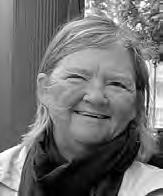 Michael J. Legge
July 6, 2022, on Bainbridge Island, Washington.
Michael J. Legge
July 6, 2022, on Bainbridge Island, Washington.
37 Reed Magazine december 2022
In Memoriam
Fred Russell ’86
June 27, 2022, in Portland, Oregon.
Fred was born in Adel, Iowa, and from a young age was concerned with the state of the world.
After reading Diet for a Small Planet as a teenager, he became a vegetarian and inspired his family to do the same. He graduated from high school and came to Reed. He loved Portland; appreciating the area’s great biking and organizations that support bicycles as transportation. He left Reed in his sophomore year, worked at the Bicycle Repair Collective for 18 years, then at Evermine Labels, and got his bachelor’s degree from Portland State University.
Fred used his bike and a hand-built trailer for transportation and shopping and never owned a car. Biking brought out his latent competitiveness, and though he never really liked competitive sports, he was known in biking circles for his hill-climbing ability. Fred was also a juggler and had a soft spot for geriatric cats, providing several with a comfortable home in their last years. He is survived by his sister, Margaret Russell.
Alice Turtledove Meyer MALS ’89
July 19, 2022, in Portland, of cancer.
Alice believed thoughtful, committed people, joining forces, could repair the world. A native Oregonian, she was born on the eve of the Great Depression to David and Fanny Turtledove, who instilled in her an ethos of political engagement and empathy. With a sense of responsibility towards the less fortunate, Alice grew into a woman who dedicated her life to community building and activism.
When she was 12 years old, her father drove her to the Portland Expo, where Japanese Americans were forced to surrender for internment. David wanted Alice to see first-hand the government’s injustice against its own citizens. She would always recall the sight of children her age peering out from behind a barbed-wire fence, about to be banished to a camp in Idaho. The experience was an early catalyst in shaping her lifelong fight for social justice.
After graduating from Grant High School, she earned a bachelor’s degree in English literature from the University of Washington. Years later, she completed her MALS degree at Reed, writing her thesis, “Laurelhurst: A Park in the Olmstead Tradition,” advised by Prof. Peter Parshall [art history 1971–2000]. While at

UW, she helped organize protests against the Canwell Committee’s persecution of “communist” faculty members.
After starting a family in the ’60s, Alice began her career as a community activist, dedicating 20 years to volunteering with the League of Women Voters of Oregon, where she created the first statewide membership drive in the country. She also led training workshops and chaired the 50th anniversary campaign.
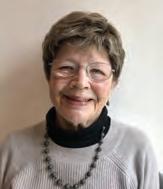
Her volunteerism on behalf of Portland causes produced tangible results in the city she loved. As board president of the Friends of the Multnomah County Library, she oversaw the establishment of an endowment fund and the creation of the Friends Library Store. That was followed by eight years as a member of the Multnomah County Library Advisory Board, including a year as chair. She also did volunteer service work for the Mt. Hood Festival of Jazz, Oregon Teachers Standards and Practices Commission, Oregon Fair Dismissal Board, Oregon Public Broadcasting’s Policy Advisory Committee, and Compassion and Choices.
Curious about the moral, ethical and practical choices brought on by living longer, Alice initiated a series of programs at Congregation Beth Israel called The Longevity Revolution, which advocated taking control of one’s senior years through thoughtful, advanced planning.
A 1988 visit to a synagogue that had become a Jewish history museum in Manchester, England, inspired Alice to do the same in Portland. She shared the idea with Rabbi Joshua Stampfer, and a dedicated team was formed to bring Alice’s vision to fruition. The Oregon Jewish Museum was established with Alice as its first board president. She guided the search to find a permanent brick and mortar home for the museum. Alice was also active in the Oregon Jewish Historical Society and served on the board of the Oregon Holocaust Resource Center, which merged with the Oregon Jewish Museum in 2014.
In response to the 2016 election, she joined Indivisible, a grassroots movement to elect progressive leaders at all levels of government. Alice believed in the democratic principle, that a passionate, educated community can bring about positive change.
She loyally and generously supported Reed, was a member of the now-defunct Reed College Women’s Committee, and co-chaired the committee’s 1996 lecture series “China Today” with Nadja Lilly ’94
Alice’s brother, Harry Turtledove ’42 , described his sister as “house mother to the world.” She sought out friendships with people of all ages and credited younger friends and family members for keeping her mind sharp and her spirit youthful.
She was married for 62 years to Paul Meyer, who predeceased her, and is survived by her three children, David, Sarah, and Andrea.
Amy Bliss Enell ’96
May 28, 2022, in Portland, from metastatic breast cancer. A theatre/dance major at Reed, Amy wrote her thesis, “Yarima, Atafa, and the King Transformation of a Hausa Folk Tale,” advised by professors Kathleen Worley [theatre 1985–2014] and Patricia Wong [dance 1975–2009].
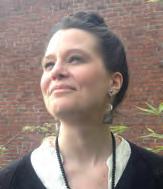
After graduation, she worked at the Meier & Frank department store in Portland and then moved on to work in the green building supply industry. Amy enjoyed swing dancing, listening to and dancing to Irish traditional music and Celtic Rock, hiking in the Arboretum, playing on the Oregon coast, and going on vacations in South Korea, where she grew to love the people and the language.
Over the last few years, she studied the art of photography, and until the last months of her life, took photos all over Portland and on the coast. She supported many causes, but especially those that helped women, children, and endangered species. Amy died at home with her parents, Trinka Enell and Roger Enell, and her stepfather, Dave Stark, at her side.
“She had a bright, loving spirit, and lived life vividly, sharing her laughter and big heart with her family and friends,” her mother said. “She was my only child, my joy, and she will be very sorely missed.”
Loleta Rae (Letty) Ernst ’00
August 1, 2022, in Redding, California, from a massive brain injury due to a fall.

Loleta Rae, known as Letty, earned a bachelor’s degree in biochemistry and molecular cell biology from Reed, where she wrote her thesis, “Regulation and Inhibition of Apoptosis by the Guanosine Binding Proteins,” advised by Prof. Laurens Rubin [biology 1955–92]. She went on to earn a master’s degree in business administration from Marylhurst University and was a Howard Hughes Medical Research fellow.
Letty worked in medical supply, device sales, and laboratory sales, among some of the brightest minds in the fields of medical research and lab esoteric testing. She was a top sales executive for the Marketo software company in the Silicon Valley, worked in marketing for Oracle, and recently was employed by LumiraDx, a COVID diagnostic testing company, reflecting her interest in immunology as shown in her thesis.
An avid gardener, she shared herbs and vegetable starters with friends, neighbors, and
38 Reed Magazine december 2022
family, and her cooking and recipes were greatly prized, with one recipe published in Sunset magazine. She was a cat fancier, passionate about abandoned cats and feral colonies, and wrote a series of children’s books featuring a cat named Mr. Winston.

Letty is survived by her grandparents, Ken and Gail Knighten, and Larry and Carol Watson; her parents, Gary and Patsy Knighten, and Ray and Sharon Ernst; her siblings, Valerie Hubbard, Heather Gard, Makenzie Knighten, and MaKylee Knighten.
Nicholas Joseph ’22
August 11, 2022 in Española, New Mexico. Nicholas blazed through life like a shooting star— catapulting himself from one passion to the next, eager to soak up every piece of knowledge and excitement the world had to offer. Born in San Diego, California, he always found new ways to have fun. As a toddler, he’d dress up as a superhero and run around the house. He was an active boy and played just about every sport possible. As the years went on, his passions for writing, literature and language took over. He graduated from High Tech High and studied Russian literature at Reed until 2020.
Nick’s greatest accomplishments were his writings. He leapt at the chance to travel, and in 2019, he spent his summer in Russia, teaching English to school children. He was a scholar and loved literature, philosophy, music, and foreign films. His books were always nearby. He was known to pack more books than clothes while traveling. One of his favorite adventures took him to a James Joyce literary pub crawl in Dublin, Ireland.

Nick had a zest for life, the gift of conversation, and the ability to be at ease with everyone. Wise beyond his years, he had a connection with the afterlife. He was in preschool when his great grandmother passed away. He told his mother not to worry, that grandma had become an angel. He knew life was larger than this world, that his time on Earth was merely a stop along the way of a great adventure. His journey has only begun. Nick is survived by his parents, Lisa and Travis, and his sister, Sierra.

Pending Obituaries
Prof. Dell Rhodes, Prof. David DeSante, Richard John Guillory ’53, Glen Wilcox ’56, Timothy Rice ’57, George Galati ’70, Herbert Grose ’74, Robert Allen Wayne ’76, Genevieve Head ’83, Kaori Hopkins O’Connor ’68.
A celebration of life for Prof. Dell Rhodes will take place Sunday, March 26, 2023, from 2 to 4 p.m., at the Performing Arts Building on the Reed Campus. For more information, contact Jeri Janowsky ’78 at jjanowskj@gmail.com.
—
grow our future. When you make a gift in your will or trust, you influence the future of Reed. Contact Kathy Saitas in the Office of Gift Planning to discuss creative and mutually beneficial ways to make a difference at Reed: 503-777-7573, giftplanning@reed.edu, or reed.edu/legacyplanning.
LIN-MANUEL MIRANDA
“What is a legacy? It’s planting seeds in a garden you never get to see."
Object of Study
What we’re looking at in class
Spiritual Ecstasy
Among Gian Lorenzo Bernini’s most famous works, the Ecstasy of Saint Teresa (1647) is housed in Santa Maria della Vittoria church in Rome. Transfixed by the vision of an angel who is on the verge of piercing her with an arrow, the enraptured Teresa reclines on a cloud, her hand and foot delicately emerging from a sea of drapery. Positioned high above eye level, the sculpture appears to defy gravity, its cascades of folds floating airily above the viewer. Rippling into surrounding space, they appear uncontained, thus challenging the idea of artworks as bounded within a frame. Movement and extravagant sinuousness replace the neat lines and contained symmetries of the Renaissance. In Spanish 344: Visual Art in Spanish Baroque Literature, we use the sculpture to talk about how baroque culture couples grandiose
aesthetic ambition with spiritual fervor and the paradoxes this generates. How can we reconcile the baroque’s investment in creating physically stunning art with its religious distrust of the sensorial world? We also discuss the discrepancies between Bernini’s highly eroticized depiction of Teresa’s ecstasy and the view of it foregrounded in a passage from the saint’s autobiographical Libro de la vida, from which the sculpture is inspired. How do texts and visual works differ in their ways of formulating the yearning for the infinite that informs mystical experience? How, in turn, does gender play into these differences? Contending with such questions is crucial to grasping the ideologically and philosophically complex nature of baroque aesthetics.

Reed Magazine december 2022 40
PROF. ARIADNA GARCÍA-BRYCE
Rediscover all that you love about Reed at Reunions!
Join your fellow alumni on campus for a spectacular weekend full of Reedie traditions, class celebrations, and more.

Does your class year end in a 3 or 8?
Join your Reunions class committee and help plan your class event. Email alumni@reed.edu to get involved.
reunions.reed.edu
REUNIONS
ALUMNI COLLEGE 2023
JUNE 7–8
Artists, Creators & Craftspersons—Here, There, and Back Again
Alumni College is back! Join us for two days of events, seminars, and workshops given by alumni for alumni, featuring Reedies who have found success through their many creative pursuits.
SAVE THE DATE
8-11 2023 JUNE

COLLEGE
Portland,
Periodicals Postage Paid Portland, Oregon
REED
3203 SE Woodstock Boulevard
Oregon 97202 -8199
photo by cornelia soma penn ’24
Kenna McCauley ’25 and Sophia Lenczowski ’25 write to randomly assigned Reed pen pals at an event hosted by Prof. Michael Stevenson Jr. [art] and students in Art 388 Social Practice as Exhibition.




 Artwork by Meredith Jensen
Artwork by Meredith Jensen
























 BY AMANDA WALDROUPE ’07
BY AMANDA WALDROUPE ’07
















































 clockwise from top left
Newlyweds Allison Morgan ’14 and Dean Schmeltz ’14 pose at the Sallyport.
PDX, Molly Radany ’11’s new business.
clockwise from top left
Newlyweds Allison Morgan ’14 and Dean Schmeltz ’14 pose at the Sallyport.
PDX, Molly Radany ’11’s new business.














 Michael J. Legge
July 6, 2022, on Bainbridge Island, Washington.
Michael J. Legge
July 6, 2022, on Bainbridge Island, Washington.









